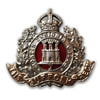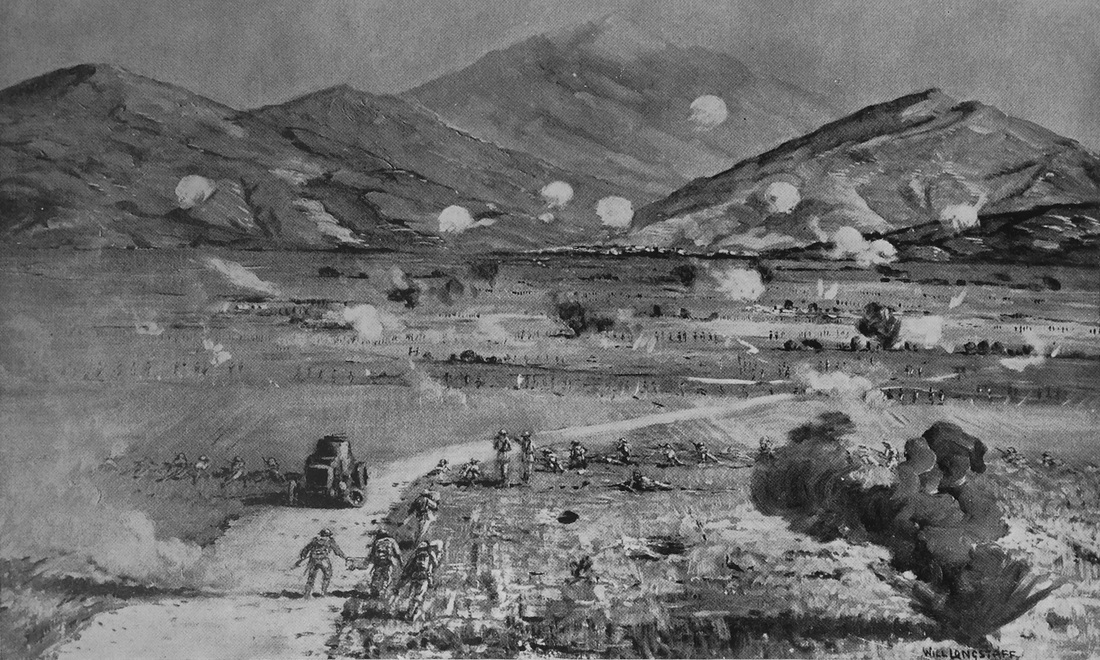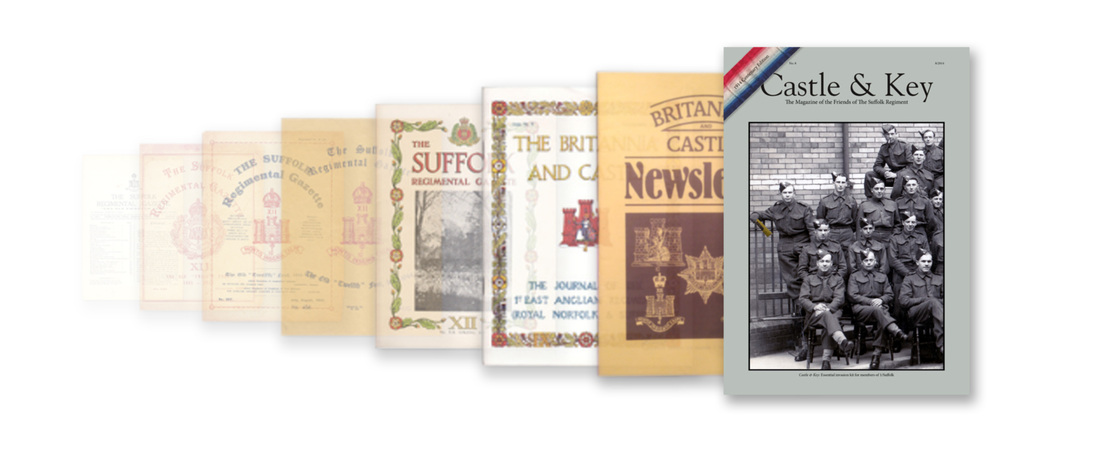2015 Friends News
2015 was an amazing year for the Friends. Membership was at an all time high and we gradually crept up the internet rankings with our revamped website. We undertook our third battlefield tour to the Western Front taking in the actions of the Regiment at the Battles of Ypres, Neuve-Chapelle and Loos. Our members did amazing things such as commemorating forgotten heroes and publishing many books. Although it was a sad year with the living face of the Regiment disappearing at an alarming scale, we felt confident that the Friends were doing their bit to ensure that the Regiment should never be forgotten. Read our year of news below to see what was going on.
Derrick Addaway - Suffolk Solider & RAF Ground Crew Mechanic
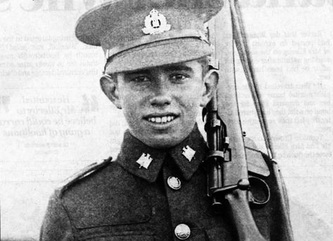
Recently stalwart RAF Association member Derrick Addaway died. His life was one of service to his country as a young ground crew mechanic during the Second World War servicing Wellington bombers, but his service career started many years before in the Suffolk Regiment.
Derrick we believe, enlisted as a Boy soldier into the Regiment around 1934-35, aged either 12 or 13. Deciding the Army was not for him, he managed somehow, to get a transfer to RAF in 1939 and remained with the junior service for the remainder of the war. The photograph left, came from a local Hull newspaper and shows Derrick in a typical inter-war Suffolk Regiment uniform.
In later life, he worked tirelessly for his local branch of the Royal Air Force Association in Hull where he lived and when he died last month, his funeral was attended by members of his former service and many ex-services associations.
(Posted 21.12.2015)
Derrick we believe, enlisted as a Boy soldier into the Regiment around 1934-35, aged either 12 or 13. Deciding the Army was not for him, he managed somehow, to get a transfer to RAF in 1939 and remained with the junior service for the remainder of the war. The photograph left, came from a local Hull newspaper and shows Derrick in a typical inter-war Suffolk Regiment uniform.
In later life, he worked tirelessly for his local branch of the Royal Air Force Association in Hull where he lived and when he died last month, his funeral was attended by members of his former service and many ex-services associations.
(Posted 21.12.2015)
Remembering Chirk
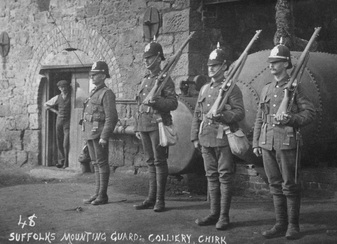
On Friday, the closure of Kellingley Colliery in Yorkshire brought to an end, deep coal mining in Britain.
The closure of the mine, reminded us that 103 years ago, 2nd Suffolk were called to assist the civil powers in protecting the working miners at the Brinkinault Colliery at Chirk on the Welsh borders. When their counterparts had gone on strike, the Battalion, who were on Home Service at the time, donning their spiked helmets to keep the striking miners from the pit gates and allow the mine to continue operating. Sections of men were also billeted underground to ensure that the striking miners did not find a way in to sabotage the props and tunnelling.
So, spare a thought for the fuel of the industrial revolution that made Britain the greatest powerhouse in the world and the tricky 'policing' role that the Army of this country were called up to perform.
(Posted: 19/12/2015)
The closure of the mine, reminded us that 103 years ago, 2nd Suffolk were called to assist the civil powers in protecting the working miners at the Brinkinault Colliery at Chirk on the Welsh borders. When their counterparts had gone on strike, the Battalion, who were on Home Service at the time, donning their spiked helmets to keep the striking miners from the pit gates and allow the mine to continue operating. Sections of men were also billeted underground to ensure that the striking miners did not find a way in to sabotage the props and tunnelling.
So, spare a thought for the fuel of the industrial revolution that made Britain the greatest powerhouse in the world and the tricky 'policing' role that the Army of this country were called up to perform.
(Posted: 19/12/2015)
5837858, Bandsman Dave Arthur
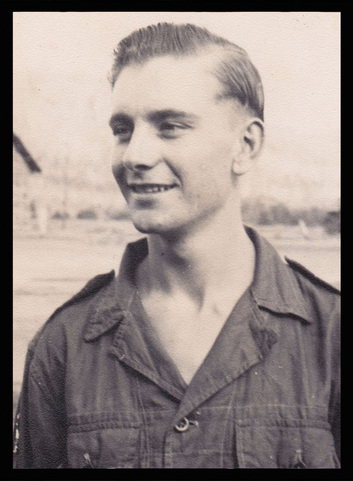
It is with much regret that we have to record the passing of No. 5837858, Bandsman Dave Arthur, who served with the 1st Battalion in Egypt, Greece, Malaya, Trieste and Germany.
Dave joined 1/Suffolk in Egypt in 1946 at a time when the Regiment still took boys under the age of 15 for a career with the Regiment. Dave along with four other boys who were enrolled the same day, had consecutive service numbers from 5837854 to 5837858; four of them would remain friends until the 1990s.
Kept apart from the rest of the Battalion, they were educated by the Regimental Schoolmaster and taught to play a variety of instruments. By the time he was 16, Dave could play at least four instruments, the minimum requirement for a Bandsman being two. His first public engagement came in 1948, when the combined massed bands of the Bedfordshire and Hertfordshire and Suffolk Regiments beat retreat in Aristotle Square, Salonika. Dave for the occasion played the piccolo.
Still classed as a 'Boy' Dave was granted the title of 'Bandsman' on his 18th birthday. Later that year in Malaya when the Battalion were short of men for active patrolling, the Band boys were granted permission to go out on patrol against the communist terrorists. Although only just 18 years old (the requirement was still 19 years old for active service), their services were invaluable at a time when the Battalion was over-stretched. However after just a few days on operations, a patrol of C Company operating in the Broga area, were ambushed by terrorists, resulting in the death of 18 year old Bandsman, Micky Swann. He was one of the five who joined with Dave - his number being three away; 5837855. Swann's death left a profound affect on the other four members of the intake. An immediate embargo was placed upon using the Band for operations and the Boys never went out on patrol again.
Upon leaving the Regular Army, Dave continued to play with the band of the 4th Battalion which was after amalgamation, the only remaining Band of The Suffolk Regiment. When the Regiment was amalgamated with The Cambridgeshire Regiment in 1961, Dave played on, but following Regiment being placed in suspended animation in 1967, the surviving band members, still keen to continue, purchased their instruments at their own expense and formed a new band; The Suffolk Concert Band, which survives to this day. Dave and fellow ex-bandsman, Ray 'Hookey' Walker, played on until the 1990s.
Dave was a stalwart member of the Ipswich Branch of the Old Comrades Association and was a regular attendee at its meetings at the TA Centre in Ipswich. When the Branch was disbanded and reformed in 2009, he attended its inaugural meeting and, to the following meeting, he brought the four surviving band boys with him who had the consecutive service numbers. Between them, they could play over 12 different instruments!
Dave had battled with illness for some time, but he was determined to attend the Ipswich Service of Remembrance in November. A very proud Bandsman was pushed in his wheel chair at the head of the parade by his daughter and his son-in-law. The bright-eyed boy was still as cheerful as always.
With surviving members of the Band of The Suffolk Regiment now exceptionally few in number, Dave's passing marks the coming to an end of another chapter in our history when soon, the Band and Drums of The Suffolk Regiment will fall silent forever.
Our thoughts are with his widow and his family at this difficult time.
Mark Forsdike, 17/12/2015
Dave joined 1/Suffolk in Egypt in 1946 at a time when the Regiment still took boys under the age of 15 for a career with the Regiment. Dave along with four other boys who were enrolled the same day, had consecutive service numbers from 5837854 to 5837858; four of them would remain friends until the 1990s.
Kept apart from the rest of the Battalion, they were educated by the Regimental Schoolmaster and taught to play a variety of instruments. By the time he was 16, Dave could play at least four instruments, the minimum requirement for a Bandsman being two. His first public engagement came in 1948, when the combined massed bands of the Bedfordshire and Hertfordshire and Suffolk Regiments beat retreat in Aristotle Square, Salonika. Dave for the occasion played the piccolo.
Still classed as a 'Boy' Dave was granted the title of 'Bandsman' on his 18th birthday. Later that year in Malaya when the Battalion were short of men for active patrolling, the Band boys were granted permission to go out on patrol against the communist terrorists. Although only just 18 years old (the requirement was still 19 years old for active service), their services were invaluable at a time when the Battalion was over-stretched. However after just a few days on operations, a patrol of C Company operating in the Broga area, were ambushed by terrorists, resulting in the death of 18 year old Bandsman, Micky Swann. He was one of the five who joined with Dave - his number being three away; 5837855. Swann's death left a profound affect on the other four members of the intake. An immediate embargo was placed upon using the Band for operations and the Boys never went out on patrol again.
Upon leaving the Regular Army, Dave continued to play with the band of the 4th Battalion which was after amalgamation, the only remaining Band of The Suffolk Regiment. When the Regiment was amalgamated with The Cambridgeshire Regiment in 1961, Dave played on, but following Regiment being placed in suspended animation in 1967, the surviving band members, still keen to continue, purchased their instruments at their own expense and formed a new band; The Suffolk Concert Band, which survives to this day. Dave and fellow ex-bandsman, Ray 'Hookey' Walker, played on until the 1990s.
Dave was a stalwart member of the Ipswich Branch of the Old Comrades Association and was a regular attendee at its meetings at the TA Centre in Ipswich. When the Branch was disbanded and reformed in 2009, he attended its inaugural meeting and, to the following meeting, he brought the four surviving band boys with him who had the consecutive service numbers. Between them, they could play over 12 different instruments!
Dave had battled with illness for some time, but he was determined to attend the Ipswich Service of Remembrance in November. A very proud Bandsman was pushed in his wheel chair at the head of the parade by his daughter and his son-in-law. The bright-eyed boy was still as cheerful as always.
With surviving members of the Band of The Suffolk Regiment now exceptionally few in number, Dave's passing marks the coming to an end of another chapter in our history when soon, the Band and Drums of The Suffolk Regiment will fall silent forever.
Our thoughts are with his widow and his family at this difficult time.
Mark Forsdike, 17/12/2015
The Suffolk Who Came In From The Cold
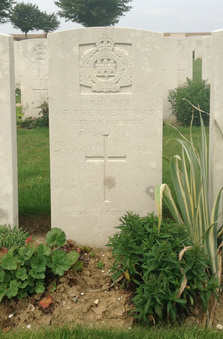
The Friends are pleased to announce that due to the sterling efforts of Friends member Kelvin Dakin of Bramford, a Suffolk Regiment soldier who for almost 100 years has been lost to history will now be commemorated by the Commonwealth War Graves Commission.
Private Thomas Ebner Elmer died in the Depot hospital at Bury St. Edmunds on 24th March 1916. He had enlisted just five days before, when he died suddenly before his training was due to commence. His death was attributed to heart failure and he was buried in Bramford cemetery with his family attending along with members of the village VTC (Volunteer Training Corps). He was 33 years old.
As he had not been issued a service number, had not gone overseas, nor had any medals been awarded to his, his death was not recorded in any of the familiar places where us regimental historians look. He had simply, disappeared. After the valiant efforts of Kelvin Dakin, who co-founded the ‘Bramford in the Great War’ Project, his story has finally come to light.
His service for his country, albeit brief, has been formally recognized and he will now be added to the CWGC register of war dead. We are as yet unsure as to whether he will receive a CWGC headstone, as he has already has a fine memorial cross erected shortly after his death, but we’ll keep you posted.
Well done to Kelvin for ensuring that another Suffolk soldier is brought in from the cold.
(Posted: 05/12/2015)
Private Thomas Ebner Elmer died in the Depot hospital at Bury St. Edmunds on 24th March 1916. He had enlisted just five days before, when he died suddenly before his training was due to commence. His death was attributed to heart failure and he was buried in Bramford cemetery with his family attending along with members of the village VTC (Volunteer Training Corps). He was 33 years old.
As he had not been issued a service number, had not gone overseas, nor had any medals been awarded to his, his death was not recorded in any of the familiar places where us regimental historians look. He had simply, disappeared. After the valiant efforts of Kelvin Dakin, who co-founded the ‘Bramford in the Great War’ Project, his story has finally come to light.
His service for his country, albeit brief, has been formally recognized and he will now be added to the CWGC register of war dead. We are as yet unsure as to whether he will receive a CWGC headstone, as he has already has a fine memorial cross erected shortly after his death, but we’ll keep you posted.
Well done to Kelvin for ensuring that another Suffolk soldier is brought in from the cold.
(Posted: 05/12/2015)
Reunited Comrades

Over Remembrance Day, a remarkable regimental event occurred. Two former Suffolk soldiers, who had both served in Germany at the war's end and later in Palestine, met up again after over 30 years.
Bob "Bonny" Parks (left) and Herbie Bright (right) both served in the 1st Battalion from 1944 to 1948. Both men, who came from Cambridgeshire, kept in contact after the war but fell out of contact in the 1970s.
Keen to get back in touch with his old wartime colleague, Mr Parks' wife looked in the telephone book and found an 'H Bright' and after ringing the number, was amazed to find it was his old chum - amazingly, living just down the road.
In a remarkable media interview, the two men were brought together for the press. However, the Friends have been able to make contact with them and hopefully, we'll be off to interview them very soon.
Bob Parks as can be seen in the photo left, has been awarded the Legion d'Honneur, so he must be a D-Day veteran. Hopefully we'll get the full story of both their Suffolk Regiment careers for a special article for the next edition of the Castle & Key.
(Originally Posted: 25/11/2015)
Bob "Bonny" Parks (left) and Herbie Bright (right) both served in the 1st Battalion from 1944 to 1948. Both men, who came from Cambridgeshire, kept in contact after the war but fell out of contact in the 1970s.
Keen to get back in touch with his old wartime colleague, Mr Parks' wife looked in the telephone book and found an 'H Bright' and after ringing the number, was amazed to find it was his old chum - amazingly, living just down the road.
In a remarkable media interview, the two men were brought together for the press. However, the Friends have been able to make contact with them and hopefully, we'll be off to interview them very soon.
Bob Parks as can be seen in the photo left, has been awarded the Legion d'Honneur, so he must be a D-Day veteran. Hopefully we'll get the full story of both their Suffolk Regiment careers for a special article for the next edition of the Castle & Key.
(Originally Posted: 25/11/2015)
Captain Rod Gray
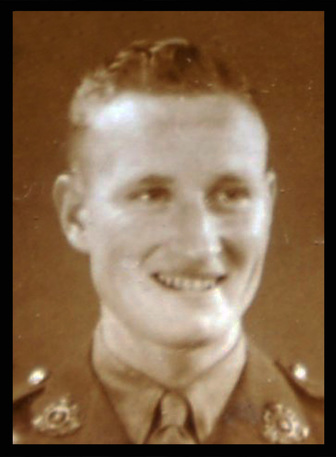
It is with sadness that we report the passing of Captain Rod Gray, formerly of 2nd Suffolk and one of the last survivors of the battles in the Arakan against the Japanese strongpoints at ‘Bamboo’ and ‘Isaac.’
Roderick Sydney Archibald Gray was born in Ipswich on 18th November 1918. Called up for National Service in October 1939, Rod completed his basic training at Bury St. Edmunds ending the six-week course as a Lance Corporal. Within weeks he had gained rapid promotion to Sergeant and at the recommendation of his then Company Commander, Major A.A. Goodwin, he was selected for officer training and sent to No. 168 Officer Cadet Training Unit (OCTU) at Droitwich. Having reached the grade he was gazetted into the Suffolk Regiment on 15th April 1941 and left England to join the 2nd Battalion in India shortly afterwards.
He joined C Company of 2nd Suffolk at Rawalpindi where they were then stationed on internal security duties. From here in 1943, he went with the Battalion to Lahore, before moving to Madras and then by boat, to the Arakan where the Battalion joined the 123rd Brigade in the 5th (Indian) Division, whose divisional sign was a red circle on a black rectangle. It earnt them the nickname of the ‘Ball of fire’ but many soldiers had a more affectionate name for the sign; the ‘flaming ar**hole’
Rod’s first patrol into the jungle was a baptism of fire. Having negotiated a rocky riverbed, his platoon came under fire from concealed Japanese positions. One man was killed and three were wounded. He managed to withdraw his men to safety and get back to C Company HQ. He later became a liaison officer between Battalion HQ and 123 Brigade, before joining 4th Division HQ.
When the Division fell back, he was transferred along with other members of the HQ staff, by Lysander aircraft to Chittagong, and from there on foot to Imphal where the 5th Division were being sent to relieve the garrison there. The advance was one of slow and hampering progress. Japanese positions on the mountain tops overlooked the valleys. If they could be dislodged, and the position taken, the Japanese would use concentrated mortar fire to dislodge the new occupiers and win the hill back. It was tough, bitter fighting. Though outnumbered by vastly superior Japanese forces, two of the key positions in the area were taken. “Bamboo” was taken on January 9th 1944, whilst not far away, “Isaac” was taken on June 5th. The Battalions actions there would earn the Regiment the Honours of “IMPHAL” and "NORTH ARAKAN."
Rod recalled his time at Isaac “I moved back to the Battalion from General HQ and was scheduled to lead my platoon in an attack with C Company. However, as I had previously completed a signals course I was told to take over the signals section as the Signals Officer was sick with a fever and unable to carry on. In the attack which I would have led; most of my platoon and a number of C Company were killed, including the company commander. I always say that my guardian angel was with me that day and saved me. I remember that my CO was told to keep attacking this position. The Japanese were in bunkers and very difficult to dislodge. I visited this hill soon after the Japanese retreated and counted literally hundreds of dead bodies.”
After internal security duties in Burma, Rod was promoted Captain and became Battalion Intelligence Officer. He accompanied the Battalion back into India in late 1945 as it once more took up the role of colonial peacekeepers before the planned independence of India in 1947. Rod returned home and was demobbed in May 1946.
Rod's funeral took place at Ipswich crematorium on 25th November 2015 and was attended by members of the Suffolk and Royal Anglian Regiments Association, Ipswich & District Branch, of which he was a member. The Branch Standard was present and his coffin was covered in the Regimental Flag. Floral tributes included a wreath of red and yellow roses from the Branch.
His passing marks the end of a poignant and often forgotten chapter of Suffolk Regiment history. He was we believe, the last surviving 2nd Battalion officer.
(Posted: 25/22/2015)
With thanks to Friend David Empson, for details of Rod's service with The Suffolk Regiment.
Every Picture Tells A Story...
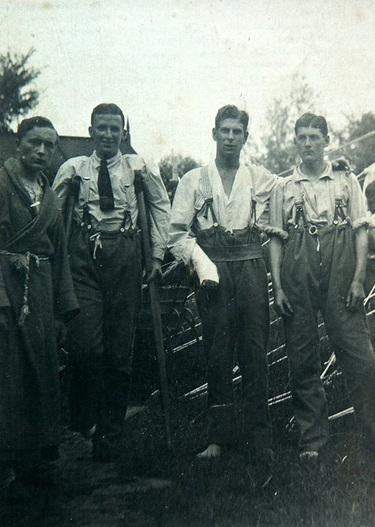
A Friend drew our attention to the cracking photograph left, of a group of Suffolk soldiers wounded during the Somme battles of 1916.
The photograph shows 2nd right, No. 17948, Private Joe Hancy of 9th Suffolk, wounded in the right arm by shrapnel as he went over the top in September 1916 as the Battalion attacked the German strongpoint named the 'Quadrilateral.'
Joe had enlisted aged 16, the previous year and had managed to get to France with a draft of men for the 9th Battalion shortly before the beginning of the battle of the Somme which commenced on 1st July 1916.
It was said that he lie wounded, alone, in a shell hole in no mans land for at least 3 days, before he was rescued and brought back to the British lines. During this time, he passed his celebrated his 17th Birthday.
The photograph left, is a rare insight into the advanced hospitals just a few miles behind the front line. Most of these were tented affairs, such as seen here; a temporary stop for the severely wounded before a journey to base hospitals and
hopefully home. The men all wear 'hospital blue' uniform which was standard for hospital patients. The loose, baggy blue serge trousers, had a drawstring waist, but also had buttons for braces as can be seen here. A white shirt was worn with a distinctive red tie.
Hancy, seen with his arm plastered, never fully recovered from the wounds he received on the Somme. In August 1917, he was decreed as unfit for military service due to paralysis in his arm. He was discharged and sent home. Under a national scheme, he obtained employment as a railwayman at a crossing in Dereham, Norfolk. A cottage came with the position which kept for many years.
If any members come across similar photographic gems on their travels, please do drop us a line and let us know.
(Posted: 20/11/2015)
The photograph shows 2nd right, No. 17948, Private Joe Hancy of 9th Suffolk, wounded in the right arm by shrapnel as he went over the top in September 1916 as the Battalion attacked the German strongpoint named the 'Quadrilateral.'
Joe had enlisted aged 16, the previous year and had managed to get to France with a draft of men for the 9th Battalion shortly before the beginning of the battle of the Somme which commenced on 1st July 1916.
It was said that he lie wounded, alone, in a shell hole in no mans land for at least 3 days, before he was rescued and brought back to the British lines. During this time, he passed his celebrated his 17th Birthday.
The photograph left, is a rare insight into the advanced hospitals just a few miles behind the front line. Most of these were tented affairs, such as seen here; a temporary stop for the severely wounded before a journey to base hospitals and
hopefully home. The men all wear 'hospital blue' uniform which was standard for hospital patients. The loose, baggy blue serge trousers, had a drawstring waist, but also had buttons for braces as can be seen here. A white shirt was worn with a distinctive red tie.
Hancy, seen with his arm plastered, never fully recovered from the wounds he received on the Somme. In August 1917, he was decreed as unfit for military service due to paralysis in his arm. He was discharged and sent home. Under a national scheme, he obtained employment as a railwayman at a crossing in Dereham, Norfolk. A cottage came with the position which kept for many years.
If any members come across similar photographic gems on their travels, please do drop us a line and let us know.
(Posted: 20/11/2015)
Remember...
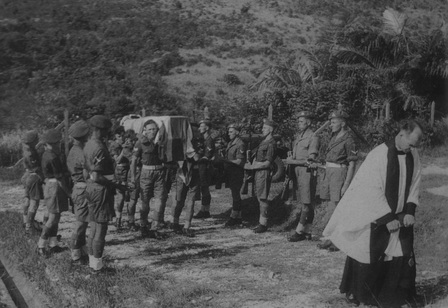
Today, as the Nation pauses to remember the fallen of two World Wars and other conflicts since, we remember all those men of the Suffolk Regiment who fought and died in the service of their country.
By the 8th November 1915; 100 years ago, the Great War had already cost the Suffolk Regiment 1233 men killed or missing. There were also many more recovering from wounds in hospitals at home and abroad.
The Regiment had seen tragedy and triumph, victory and failure during first 15th months of war. It had served in France and Flanders, at Gallipoli and in Salonika, and would go on to serve in many more places around the world before the conflict would end.
Please spare a thought today, and over the forthcoming days to remember all those of The Suffolk Regiment and the old XIIth Foot, who since the raising of the Regiment in 1685, have in many lands, given their lives for their country.
Now and always, we will remember them.
(Posted: 11/11/2015)
By the 8th November 1915; 100 years ago, the Great War had already cost the Suffolk Regiment 1233 men killed or missing. There were also many more recovering from wounds in hospitals at home and abroad.
The Regiment had seen tragedy and triumph, victory and failure during first 15th months of war. It had served in France and Flanders, at Gallipoli and in Salonika, and would go on to serve in many more places around the world before the conflict would end.
Please spare a thought today, and over the forthcoming days to remember all those of The Suffolk Regiment and the old XIIth Foot, who since the raising of the Regiment in 1685, have in many lands, given their lives for their country.
Now and always, we will remember them.
(Posted: 11/11/2015)
Sergeant Gordon Broughton
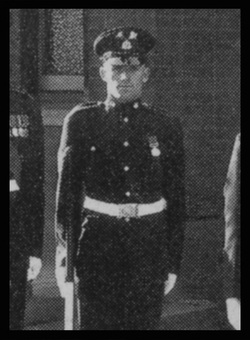
In this time of remembrance, it is particularly sad that we have to report the passing of Sergeant Gordon Broughton; formerly of 1st Suffolk, and for many years, the Secretary of the Sergeants Mess Dinner Club.
A regular soldier, Gordon joined the 1st Battalion in Malaya in late 1951, and by early 1952, he had been promoted to Lance Corporal after just four weeks patrolling. By the middle of 1952, he had been promoted to Corporal and had moved from patrolling in the jungle, to the MT section, then based at Wardiburn Camp.
Gordon was the MT Corporal and ran the MT pool until the Battalion returned home in January 1953. He had originally served under Captain Frank Lockett, but when Frank went off to command C Company, command of the MT Section passed to Captain Harold Wiggington. Gordon's primary job was to ensure that the Battalion's fleet of vehicles were kept in order and properly maintained; no mean feat considering that most of the trucks were of wartime American manufacture and obtaining spares was almost impossible. He remarked later that he was thankful when a truck was wrecked as it gave them a chance to restock the spares shelves!
He had a notible flair for mechanics and one night his skills were called upon when the then commander of D Company; Major Bevan rang up the MT Garage direct to ask for assistance when his Fiat car had broken down on the way back from a night in town. Gordon and another Corporal went out in a jeep and tried to get it started. Trying to work in the cramped engine bay was a knighmare, so they removed the bonnet and placed it by the roadside. After much tinkering, they succeeded in the pitch darkness to get it started again. Happy, Major Bevan drove off, leaving Gordon to follow, it was only when they got back to camp the following morning, that they realised they had left the bonnet of the Fiat behind and had to go back and get it!
Upon return to the UK, Gordon was selected in 1953, to be part of the escort for the Suffolk Regiment Colours on the Coronation Parade of Queen Elizabeth II; an honour he always considered, to be the highlight of his Suffolk Regiment career. Major Bevan; the detachment commander, chose Gordon to participate in view of coolness he had shown that night in getting his car started, and his discretion in keeping the whole affair quiet!
It was whilst on the Parade route, in a halt in the rain outside the Cafe Royal, that one of the water soaked, ancient, 103 year-old Colours came adrift and started to slide down its pole. In a moment of quick thinking, Major Bevan produced a spare leather bootlace and Gordon succeeded, with much reverential respect for the Colours, in tying the ancient silk back into place on the pole with the bootlace. It held for the parade and a further two years before they were finally replaced.
Promoted to Sergeant in 1955, Gordon left the regular Battalion and took up a temporary administrative position in the 4th (Territorial) Battalion, before retiring to join the Norfolk Fire Service. He would remain with them for another 25 years.
In later life, he kept in touch with the Regiment, being an active member of the Sergeants Mess Dinner Club, latterly becoming is secretary and organiser, before the club finally finished meeting in 2005. He had bravely battled illness for some years, and yet even when very ill, he still attended as many Old Comrades functions as he could including the Diss Malaya veterans luncheons, the annual pig roast at Peterborough and the Ipswich Branch BBQs held by Dick and Jackie May.
One of the last two survivors of the Coronation Parade, Gordon was a man of an extraordinarily likeable character who never suffered fools gladly. His upright bearing, soldierly appearance and Panama hat with its distinctive Regimental ribbon, will be much missed at Regimental functions. Our thoughts are with his widow Brenda, his family and old comrades at this difficult time.
Mark Forsdike, 06/11/2015
A regular soldier, Gordon joined the 1st Battalion in Malaya in late 1951, and by early 1952, he had been promoted to Lance Corporal after just four weeks patrolling. By the middle of 1952, he had been promoted to Corporal and had moved from patrolling in the jungle, to the MT section, then based at Wardiburn Camp.
Gordon was the MT Corporal and ran the MT pool until the Battalion returned home in January 1953. He had originally served under Captain Frank Lockett, but when Frank went off to command C Company, command of the MT Section passed to Captain Harold Wiggington. Gordon's primary job was to ensure that the Battalion's fleet of vehicles were kept in order and properly maintained; no mean feat considering that most of the trucks were of wartime American manufacture and obtaining spares was almost impossible. He remarked later that he was thankful when a truck was wrecked as it gave them a chance to restock the spares shelves!
He had a notible flair for mechanics and one night his skills were called upon when the then commander of D Company; Major Bevan rang up the MT Garage direct to ask for assistance when his Fiat car had broken down on the way back from a night in town. Gordon and another Corporal went out in a jeep and tried to get it started. Trying to work in the cramped engine bay was a knighmare, so they removed the bonnet and placed it by the roadside. After much tinkering, they succeeded in the pitch darkness to get it started again. Happy, Major Bevan drove off, leaving Gordon to follow, it was only when they got back to camp the following morning, that they realised they had left the bonnet of the Fiat behind and had to go back and get it!
Upon return to the UK, Gordon was selected in 1953, to be part of the escort for the Suffolk Regiment Colours on the Coronation Parade of Queen Elizabeth II; an honour he always considered, to be the highlight of his Suffolk Regiment career. Major Bevan; the detachment commander, chose Gordon to participate in view of coolness he had shown that night in getting his car started, and his discretion in keeping the whole affair quiet!
It was whilst on the Parade route, in a halt in the rain outside the Cafe Royal, that one of the water soaked, ancient, 103 year-old Colours came adrift and started to slide down its pole. In a moment of quick thinking, Major Bevan produced a spare leather bootlace and Gordon succeeded, with much reverential respect for the Colours, in tying the ancient silk back into place on the pole with the bootlace. It held for the parade and a further two years before they were finally replaced.
Promoted to Sergeant in 1955, Gordon left the regular Battalion and took up a temporary administrative position in the 4th (Territorial) Battalion, before retiring to join the Norfolk Fire Service. He would remain with them for another 25 years.
In later life, he kept in touch with the Regiment, being an active member of the Sergeants Mess Dinner Club, latterly becoming is secretary and organiser, before the club finally finished meeting in 2005. He had bravely battled illness for some years, and yet even when very ill, he still attended as many Old Comrades functions as he could including the Diss Malaya veterans luncheons, the annual pig roast at Peterborough and the Ipswich Branch BBQs held by Dick and Jackie May.
One of the last two survivors of the Coronation Parade, Gordon was a man of an extraordinarily likeable character who never suffered fools gladly. His upright bearing, soldierly appearance and Panama hat with its distinctive Regimental ribbon, will be much missed at Regimental functions. Our thoughts are with his widow Brenda, his family and old comrades at this difficult time.
Mark Forsdike, 06/11/2015
One Of The Last
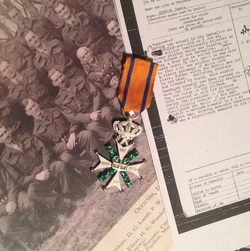
This afternoon the Friends spent many pleasurable hours interviewing one of our last surviving D-Day veterans.
In a three hour-long interview which took us from his commissioning into The Suffolk Regiment and joining the 1st Battalion at Frome in September 1940, to his being invalided home after being wounded in action whilst commanding a Company of the Battalion in early 1945.
We chatted about those who came and went. Of how his carriers were greased and waterproofed with bostik before they landed on the Normandy beaches, and of how he was wounded first in the same action at Venray that cost the Battalion it's then CO; Lieutenant Colonel Craddock. It was a remarkable story of a remarkable career with The Suffolk Regiment, recalled by a very modest man.
A full story will appear in a future edition of the Castle and Key, but until then, this is merely a teaser!
(Posted: 22/09/2015)
In a three hour-long interview which took us from his commissioning into The Suffolk Regiment and joining the 1st Battalion at Frome in September 1940, to his being invalided home after being wounded in action whilst commanding a Company of the Battalion in early 1945.
We chatted about those who came and went. Of how his carriers were greased and waterproofed with bostik before they landed on the Normandy beaches, and of how he was wounded first in the same action at Venray that cost the Battalion it's then CO; Lieutenant Colonel Craddock. It was a remarkable story of a remarkable career with The Suffolk Regiment, recalled by a very modest man.
A full story will appear in a future edition of the Castle and Key, but until then, this is merely a teaser!
(Posted: 22/09/2015)
Christmas Sorted!

Regretfully, we are those sort of "Bah Humbug" people when it comes to Christmas. No sooner have we said goodbye to summer, then the shops are stacked with halloween novelties, followed shortly afterwards by the mass influx of Christmas decorations and trees. Always stumped to find that 'amazing' christmas present for our loved ones, luckily this year eBay provided the answer.
Recently a beautiful pair of silver and gold earrings in the form of the Regimental Crest came up for sale. Made by the then Crown Jewellers; Garrard and Co., amazingly, no-one else bid on them and we managed to get them for the opening bid. Incredibly detailed they are only just 12mm high.
The use of the crest for jewellery was spawned after the Regiment presented their new Colonel-in-Chief, H.R.H. The Princess Margaret, with a brooch of similar design upon her appointment in 1954. In its wake, many officers and men, followed suit and commissioned similar pieces for they loved ones. The hall marks for these earrings, date them to 1959; the year of amalgamation, but we've already dropped Garrard an email to see if we can track down who originally commissioned them.
Hopefully she'll like them but if she doesn't, I'll pierce my own ears and wear them instead!
Posted: 15/09/2015)
Recently a beautiful pair of silver and gold earrings in the form of the Regimental Crest came up for sale. Made by the then Crown Jewellers; Garrard and Co., amazingly, no-one else bid on them and we managed to get them for the opening bid. Incredibly detailed they are only just 12mm high.
The use of the crest for jewellery was spawned after the Regiment presented their new Colonel-in-Chief, H.R.H. The Princess Margaret, with a brooch of similar design upon her appointment in 1954. In its wake, many officers and men, followed suit and commissioned similar pieces for they loved ones. The hall marks for these earrings, date them to 1959; the year of amalgamation, but we've already dropped Garrard an email to see if we can track down who originally commissioned them.
Hopefully she'll like them but if she doesn't, I'll pierce my own ears and wear them instead!
Posted: 15/09/2015)
Ipswich Names It's Newest Busses After Town's VC Winners
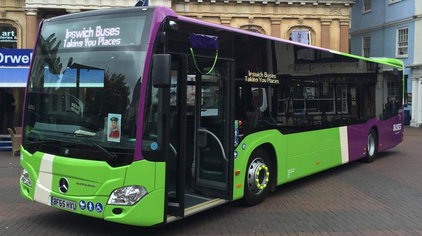
On Wednesday 7th October, Ipswich Busses unveiled the latest editions to their fleet of vehicles.
The two new Mercedes busses have been named in this centenary year, after the town's two Victoria Cross winners; Sergeant Arthur Saunders of 9th Battalion, The Suffolk Regiment, and Private Sam Harvey of 1st Battalion, York and Lancaster Regiment; both of whom won their awards at the battle of Loos in September 1915.
The formal naming of both vehicles was attended by members of the Saunders and Harvey families, together with the Mayor of Ipswich, Councillor Glen Chisholm.
A fitting and practical memorial to two brave sons of the borough.
(Posted: 10/10/2015)
The two new Mercedes busses have been named in this centenary year, after the town's two Victoria Cross winners; Sergeant Arthur Saunders of 9th Battalion, The Suffolk Regiment, and Private Sam Harvey of 1st Battalion, York and Lancaster Regiment; both of whom won their awards at the battle of Loos in September 1915.
The formal naming of both vehicles was attended by members of the Saunders and Harvey families, together with the Mayor of Ipswich, Councillor Glen Chisholm.
A fitting and practical memorial to two brave sons of the borough.
(Posted: 10/10/2015)
"In Search Of Great Uncle Frank:" BBC Radio 4 Documentary on 1/5th Suffolk
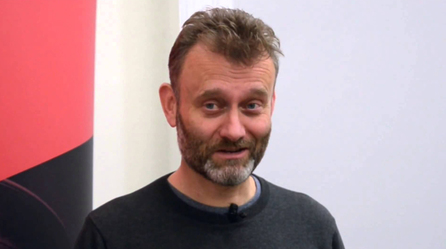
On Monday 12th October, BBC Radio 4 will air "In Search Of Great Uncle Frank" - a short documentary which takes the comedian Hugh Dennis to the Gallipoli peninsular in search of the story of his great uncle, Frank Hinnells, a private in 1/5th Battalion, The Suffolk Regiment.
Hinnells, a member of D Company was killed in action on 17th October 1915, when the Battalion were holding the front line around Hill 6o. Frank's older brother Godfrey also served with The Suffolk Regiment, but with the 4th Battalion on the Western Front.
The programme will air at 11.00am on BBC Radio 4 and will be available later on the BBC iPlayer.
(Posted: 10/10/2015)
Hinnells, a member of D Company was killed in action on 17th October 1915, when the Battalion were holding the front line around Hill 6o. Frank's older brother Godfrey also served with The Suffolk Regiment, but with the 4th Battalion on the Western Front.
The programme will air at 11.00am on BBC Radio 4 and will be available later on the BBC iPlayer.
(Posted: 10/10/2015)
Ipswich Honours It's VC Heroes
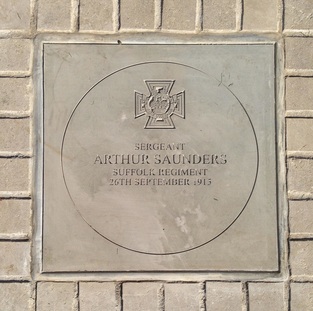
This morning, the Friends were in Ipswich to attend the unveiling of two commemorative paving stones to the two Victoria Cross winners of the Borough.
Private Samuel Harvey and Sergeant Arthur Saunders both won their VCs during the Battle of Loos in September 1915, and today, exactly 100 years to the day since Sergeant Saunders won his VC whilst serving with the 9th (Service) Battalion, The Suffolk Regiment, the Mayor and Ipswich Borough Council, honoured these two heroes in a special service of dedication.
Friends Chairman Taff Gillingham read out the biographies of each recipient after which, members of the Saunders and Harvey families were invited by the Mayor of Ipswich, Councillor Glen Chisholm, to formally unveil the plaques.
A special exhibition was held in the Town Hall to commemorate the event and thanks must go to Friends members Derek Pheasant, Kelvin Dakin, Derek Francis and Town Sergeant, Andrew Beal for their dedicated work in making this exhibition such a success.
Private Sam Harvey won his VC whilst serving with the 1st Battalion, York and Lancaster Regiment on 29th September 1915, but he had started his military career serving with the 3rd (Militia) Battalion of the Suffolk Regiment in the early 1900s.
A grateful Borough has today finally honoured two of its greatest heroes. Please therefore spare a thought today for all those men of the 9th Battalion who, after a long march to the front, were thrown straight into battle against a determined enemy. They made great advances and showed great valour, but for the unavailability of reserves to exploit the gains they made that day, they were ultimately forced to retire.
Lest we forget.
(Posted: 26/09/2015)
Private Samuel Harvey and Sergeant Arthur Saunders both won their VCs during the Battle of Loos in September 1915, and today, exactly 100 years to the day since Sergeant Saunders won his VC whilst serving with the 9th (Service) Battalion, The Suffolk Regiment, the Mayor and Ipswich Borough Council, honoured these two heroes in a special service of dedication.
Friends Chairman Taff Gillingham read out the biographies of each recipient after which, members of the Saunders and Harvey families were invited by the Mayor of Ipswich, Councillor Glen Chisholm, to formally unveil the plaques.
A special exhibition was held in the Town Hall to commemorate the event and thanks must go to Friends members Derek Pheasant, Kelvin Dakin, Derek Francis and Town Sergeant, Andrew Beal for their dedicated work in making this exhibition such a success.
Private Sam Harvey won his VC whilst serving with the 1st Battalion, York and Lancaster Regiment on 29th September 1915, but he had started his military career serving with the 3rd (Militia) Battalion of the Suffolk Regiment in the early 1900s.
A grateful Borough has today finally honoured two of its greatest heroes. Please therefore spare a thought today for all those men of the 9th Battalion who, after a long march to the front, were thrown straight into battle against a determined enemy. They made great advances and showed great valour, but for the unavailability of reserves to exploit the gains they made that day, they were ultimately forced to retire.
Lest we forget.
(Posted: 26/09/2015)
A Great Evening Out With Martin Bell
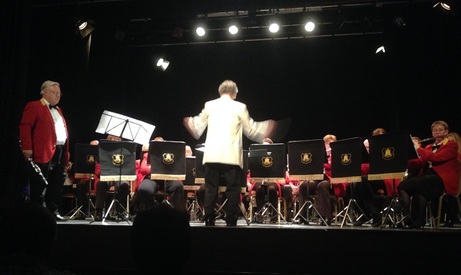
Tonight, the Friends were in Bury St. Edmunds to attend an evening with Martin Bell and the Suffolk Concert Band.
Martin who served with 1/Suffolk in Cyprus, was sharing some reminiscences of his time with The Suffolk Regiment and his likes and dislikes of those who commanded him! He was also there to promote his new and excellent book "The End of Empire."
Accompanying Martin was the ever superb Suffolk Concert Band, which has since its creation in 1967, had very close links with the Suffolk Regiment. It was formed from the musicians of the Band of the Suffolk and Cambridgeshire Regiment (TA) who following its disbandment in 1967, decided to 'play on' and formed the Suffolk Concert Band.
The Band's close ties with the Regiment have seen Martin as its President for many years, taking over for the late Lieutenant General Sir Richard Goodwin, who was its President form 1967 until 1985. The Band as always, ended their evening by playing the Regimental March Speed the Plough, to which all in the audience, stood to attention. The Band will be 50 years old in two years time and plans are afoot to celebrate their historic milestone by bringing them back to the Depot to play once more.
(Posted: 25/09/2015)
Martin who served with 1/Suffolk in Cyprus, was sharing some reminiscences of his time with The Suffolk Regiment and his likes and dislikes of those who commanded him! He was also there to promote his new and excellent book "The End of Empire."
Accompanying Martin was the ever superb Suffolk Concert Band, which has since its creation in 1967, had very close links with the Suffolk Regiment. It was formed from the musicians of the Band of the Suffolk and Cambridgeshire Regiment (TA) who following its disbandment in 1967, decided to 'play on' and formed the Suffolk Concert Band.
The Band's close ties with the Regiment have seen Martin as its President for many years, taking over for the late Lieutenant General Sir Richard Goodwin, who was its President form 1967 until 1985. The Band as always, ended their evening by playing the Regimental March Speed the Plough, to which all in the audience, stood to attention. The Band will be 50 years old in two years time and plans are afoot to celebrate their historic milestone by bringing them back to the Depot to play once more.
(Posted: 25/09/2015)
Never Knowingly Undersold!
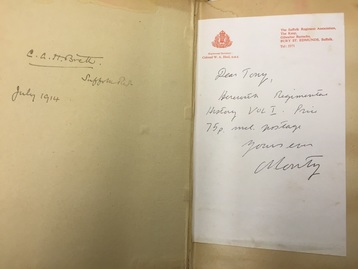
In the effects of the late Major Tony Cobbold, there was reputedly a copy of Colonel E.A.H.Webb's first volume of Regimental History (1685-1913) that was gifted to him by Colonel Brett's daughter when Tony was curator of the Suffolk Regiment Museum in the mid 1970s.
The book it was rumoured, was signed by the legend himself; Lieutenant-Colonel C.A.H. Brett DSO, Commanding Officer of 2nd Suffolk, who was killed at Le Cateau in August 1914.
Following Tony's passing earlier this year, the book has recently appeared. His copy, which finally surfaced was after inspection, indeed the one belonging to Colonel Brett, posted to him whilst commanding the Battalion at the Curragh in July 1914. His name was written in the front in his own hand. However, tucked in the front of the book was a letter from Tony's predecessor, the then curator of the Regimental Museum, Lieutenant H.R. Case. It ran "Dear Tony, Herewith Regimental History Vol. I. Price 75p and postage. Yours ever, Monty"
It seems perhaps that after all the story surrounding it that Tony had purchased a duplicate copy from the museum in the early 70s. It was quite common in those days that duplicate copies that were gifted from the estates of deceased officers, were sold to support Regimental funds, and this we surmise is how Tony obtained his copy. Having many copies to hand, perhaps Monty just posted Tony the nearest copy to hand, ignorant of the importance of its former owner.
Whatever the circumstances, the story was a great one and one which we've lived with and waited to verify for over 20 years. We're not disappointed in how he obtained it, only that it really is the great man's copy.
(Posted: 24/09/2015)
The book it was rumoured, was signed by the legend himself; Lieutenant-Colonel C.A.H. Brett DSO, Commanding Officer of 2nd Suffolk, who was killed at Le Cateau in August 1914.
Following Tony's passing earlier this year, the book has recently appeared. His copy, which finally surfaced was after inspection, indeed the one belonging to Colonel Brett, posted to him whilst commanding the Battalion at the Curragh in July 1914. His name was written in the front in his own hand. However, tucked in the front of the book was a letter from Tony's predecessor, the then curator of the Regimental Museum, Lieutenant H.R. Case. It ran "Dear Tony, Herewith Regimental History Vol. I. Price 75p and postage. Yours ever, Monty"
It seems perhaps that after all the story surrounding it that Tony had purchased a duplicate copy from the museum in the early 70s. It was quite common in those days that duplicate copies that were gifted from the estates of deceased officers, were sold to support Regimental funds, and this we surmise is how Tony obtained his copy. Having many copies to hand, perhaps Monty just posted Tony the nearest copy to hand, ignorant of the importance of its former owner.
Whatever the circumstances, the story was a great one and one which we've lived with and waited to verify for over 20 years. We're not disappointed in how he obtained it, only that it really is the great man's copy.
(Posted: 24/09/2015)
A Momentous Day Worthy Of Celebration
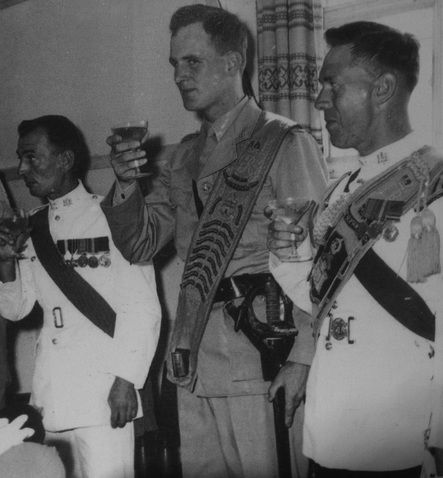
Today, the Prime Minister led the nation in a day of remembrance to mark the 75th anniversary of the pivotal day in the 'Battle of Britain.'
In the summer of 1940 whilst a small band of allied fighter pilots fought for the survival of this island, the men of the Suffolk Regiment were playing their part in the defence of this island. The 1st Battalion, devoid of equipment was in the first stages of recovery following their retreat from Dunkirk. The 4th and 5th Battalions were in North Norfolk on coastal defence, whilst the embryonic 7th and 8th Battalions were just being formed.
However today is momentous day for another reason. After almost three years, the Friends have finally reached the front page of Google when you search for "The Suffolk Regiment."
Our newly revamped website, our ongoing chronicling of the Regiment's part in the Great War, and our continued news, have all lead to our ratings dramatically increasing since the spring.
We'd like to thank you all for your continued support in keeping the history and the traditions of the Suffolk Regiment alive and join with us today in remembering those gallant 'few' who 75 years ago, stopped the Luftwaffe flattening the airfields of southern England and prevented a German invasion of this island.
"Never in the field of human conflict, was so much owed, by so many, to so few."
(Posted: 15/09/2015)
In the summer of 1940 whilst a small band of allied fighter pilots fought for the survival of this island, the men of the Suffolk Regiment were playing their part in the defence of this island. The 1st Battalion, devoid of equipment was in the first stages of recovery following their retreat from Dunkirk. The 4th and 5th Battalions were in North Norfolk on coastal defence, whilst the embryonic 7th and 8th Battalions were just being formed.
However today is momentous day for another reason. After almost three years, the Friends have finally reached the front page of Google when you search for "The Suffolk Regiment."
Our newly revamped website, our ongoing chronicling of the Regiment's part in the Great War, and our continued news, have all lead to our ratings dramatically increasing since the spring.
We'd like to thank you all for your continued support in keeping the history and the traditions of the Suffolk Regiment alive and join with us today in remembering those gallant 'few' who 75 years ago, stopped the Luftwaffe flattening the airfields of southern England and prevented a German invasion of this island.
"Never in the field of human conflict, was so much owed, by so many, to so few."
(Posted: 15/09/2015)
Long May She Reign
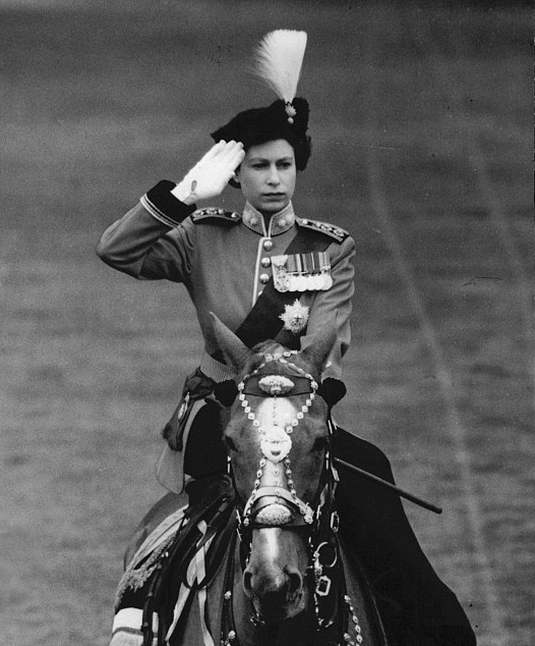
This evening, Her Majesty Queen Elizabeth II, became the longest reigning British Monarch, overtaking the great reign of her Great, Great Grandmother; Queen Victoria, who ruled for 63 years from 1837 until 1901.
The relationship between the Monarch and The Suffolk Regiment has always been a close one. At its creation in 1685, the Regiment encompassed a loyal Company of men from the Garrison at Windsor Castle and was much favoured by King James II.
In 1743 at the Battle of Dettingen, the bond between the Monarch and the Regiment was made stronger when His Majesty, King George II, placed himself at the head of the 12th Regiment and led his men into battle. It was the last time that an English King led his Army into battle against his enemies.
In the 274 years that the Regiment was in existence, it has loyally served 15 Monarchs from the Houses of Stuart, Hanover, Saxe-Coburg & Gotha and Windsor. It was in 1953, honoured by Her Majesty, with the appointment of a Royal Colonel-in-Chief; Her Royal Highness, The Princess Margaret.
Were this an age of telegrams, we would have sent the following to Her Majesty: "To the Private Secretary, The Queen, Buckingham Palace, S.W. All Officers and Men of The Suffolk Regiment and all members of The Friends of The Suffolk Regiment, wish to express to Her Majesty and the Royal Family, our most sincere congratulations on her becoming the longest reigning British Monarch."
The Queen has set us a shining example of courage, faith and devotion to duty. Long may she continue to reign over us.
(Posted: 09/09/2015)
The relationship between the Monarch and The Suffolk Regiment has always been a close one. At its creation in 1685, the Regiment encompassed a loyal Company of men from the Garrison at Windsor Castle and was much favoured by King James II.
In 1743 at the Battle of Dettingen, the bond between the Monarch and the Regiment was made stronger when His Majesty, King George II, placed himself at the head of the 12th Regiment and led his men into battle. It was the last time that an English King led his Army into battle against his enemies.
In the 274 years that the Regiment was in existence, it has loyally served 15 Monarchs from the Houses of Stuart, Hanover, Saxe-Coburg & Gotha and Windsor. It was in 1953, honoured by Her Majesty, with the appointment of a Royal Colonel-in-Chief; Her Royal Highness, The Princess Margaret.
Were this an age of telegrams, we would have sent the following to Her Majesty: "To the Private Secretary, The Queen, Buckingham Palace, S.W. All Officers and Men of The Suffolk Regiment and all members of The Friends of The Suffolk Regiment, wish to express to Her Majesty and the Royal Family, our most sincere congratulations on her becoming the longest reigning British Monarch."
The Queen has set us a shining example of courage, faith and devotion to duty. Long may she continue to reign over us.
(Posted: 09/09/2015)
14890603, James Farthing, 2nd Suffolk
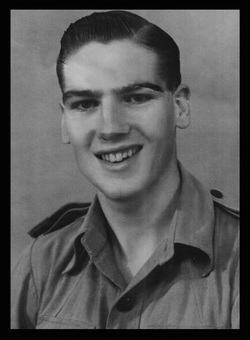
The Friends have recently received the sad news of the passing of 14890603, Private James Farthing, formerly of 2nd Suffolk who served in the Far East from 1944, until the Battalion was placed into suspended animation in India in 1947.
James was long serving member of the Felixstowe Branch of the Suffolk Regiment Old Comrades Association and a regular at Minden Day reunions at Bury St. Edmunds over the years. After service with the Suffolk Regiment, he served with the Essex Regiment.
James's funeral will take place at Seven Hills Crematorium, Ipswich on Tuesday 15 September at 14.15pm. Any former comrades of James's are invited to attend.
Our thoughts are with James's son Andrew, and his family at this difficult time. His passing signifies another chapter in our Regimental history which is slowly drawing to a close, for the surviving members of "The Battalion in the East" must now be very few in number.
"Stabilis"
(Posted: 03/09/2015)
James was long serving member of the Felixstowe Branch of the Suffolk Regiment Old Comrades Association and a regular at Minden Day reunions at Bury St. Edmunds over the years. After service with the Suffolk Regiment, he served with the Essex Regiment.
James's funeral will take place at Seven Hills Crematorium, Ipswich on Tuesday 15 September at 14.15pm. Any former comrades of James's are invited to attend.
Our thoughts are with James's son Andrew, and his family at this difficult time. His passing signifies another chapter in our Regimental history which is slowly drawing to a close, for the surviving members of "The Battalion in the East" must now be very few in number.
"Stabilis"
(Posted: 03/09/2015)
Friend Len Spicer's Book "The Suffolks In Malaya" Republished
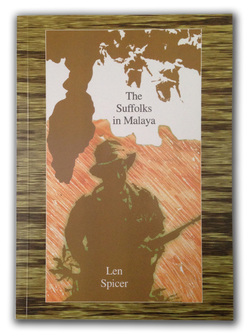
We are pleased to announce that Friends member and former Suffolk Regiment soldier, Len Spicer has just republished his book 'The Suffolks in Malaya' - the seminal work of the 1st Battalion's role in the Malayan Emergency between 1949 and 1952.
Len, who originally served with D Company, moved to work in the Battalion's Intelligence Section, commanded by Major E.H. Morgan MC. Together in close co-operation with the local Federation of Malaya Police, the Intelligence Section was the 'clearing house' of all information coming into the Battalion regarding the whereabouts of the terrorists or 'bandits.' This information was then disseminated and distributed to the various platoons, who acted upon it and led patrols out to search for enemy.
First printed in 1998 and then revised in 2000, the book charts the activities of the Battalion from their arrival from Greece in August 1949, to their completing their tour of operations in January 1953. Packed with amazing detail, Len's book chronicles the day-to-day campaigning of the Battalion with their successes and failures against the Bandits.
Interspersed with details of sporting events and social highlights of the Regiment's tour such as Minden Day and the King's Birthday Parade, this book is a must for anyone wishing to know what the Suffolk Regiment did during the Malayan Emergency. It is the definitive work of their part in the campaign.
Len's book was originally published in paperback, but now due to increased demand, he had now re-published it in electronic format, available to buy for the very reasonable price of £2.99 from Amazon: http://www.amazon.co.uk Len has also got his own website: www.lenspicer.talktalk.net and a Facebook page: https://www.facebook.com/pages/The-Suffolks-In-Malaya/566670450011983
Please do purchase a copy of this excellent book telling the story of the Suffolk Regiment's most successful post-war operational tour, for Len is most generously donating all proceeds from its sale (like all the previous paper copies sold) to the Suffolk Regiment Museum.
(Posted: 01/09/2015)
Len, who originally served with D Company, moved to work in the Battalion's Intelligence Section, commanded by Major E.H. Morgan MC. Together in close co-operation with the local Federation of Malaya Police, the Intelligence Section was the 'clearing house' of all information coming into the Battalion regarding the whereabouts of the terrorists or 'bandits.' This information was then disseminated and distributed to the various platoons, who acted upon it and led patrols out to search for enemy.
First printed in 1998 and then revised in 2000, the book charts the activities of the Battalion from their arrival from Greece in August 1949, to their completing their tour of operations in January 1953. Packed with amazing detail, Len's book chronicles the day-to-day campaigning of the Battalion with their successes and failures against the Bandits.
Interspersed with details of sporting events and social highlights of the Regiment's tour such as Minden Day and the King's Birthday Parade, this book is a must for anyone wishing to know what the Suffolk Regiment did during the Malayan Emergency. It is the definitive work of their part in the campaign.
Len's book was originally published in paperback, but now due to increased demand, he had now re-published it in electronic format, available to buy for the very reasonable price of £2.99 from Amazon: http://www.amazon.co.uk Len has also got his own website: www.lenspicer.talktalk.net and a Facebook page: https://www.facebook.com/pages/The-Suffolks-In-Malaya/566670450011983
Please do purchase a copy of this excellent book telling the story of the Suffolk Regiment's most successful post-war operational tour, for Len is most generously donating all proceeds from its sale (like all the previous paper copies sold) to the Suffolk Regiment Museum.
(Posted: 01/09/2015)
Was It All Really Necessary?
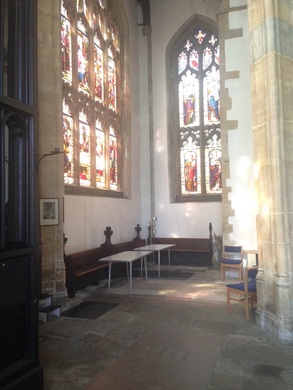
Exactly one year since the Regimental Cenotaph was moved from its original position in St. Wolstans Chapel, to a new location in St. Marys church, Bury St. Edmunds, the Friends ventured back to find out if the proposed kitchen that was so 'desperately needed' and which prompted the Cenotaphs move, had actually been built.
It came as no great surprise to us that St. Wolstan’s chapel was still empty and as 'quiet as the tomb' (to use a religious pun) and no kitchen could be seen in sight.
The Cenotaph in its new position further down the church, has now been abutted by a set of pews making viewing the 2nd Battalion Colours of 1935, a bit of a task and the memorial tablet to Lieutenant Colonel C.A.H. Brett, is still obscured by the heater which resides in front of it.
Last year the Friends campaigned vigorously against moving the Cenotaph and questioned why on the eve of the centenary of the outbreak of the Great War, were the church contemplating such an act.
Although the sunlight pierced the ornate stained glass today in St. Wolstans, it was nothing compared to seeing it shimmering off the alabaster Cenotaph that once stood there. With no Colours fluttering gently overhead, it felt a soul-less place today. With a distinct lack of building work one year on, again we ask “was it all really necessary?”
(Posted: 23/08/2015)
It came as no great surprise to us that St. Wolstan’s chapel was still empty and as 'quiet as the tomb' (to use a religious pun) and no kitchen could be seen in sight.
The Cenotaph in its new position further down the church, has now been abutted by a set of pews making viewing the 2nd Battalion Colours of 1935, a bit of a task and the memorial tablet to Lieutenant Colonel C.A.H. Brett, is still obscured by the heater which resides in front of it.
Last year the Friends campaigned vigorously against moving the Cenotaph and questioned why on the eve of the centenary of the outbreak of the Great War, were the church contemplating such an act.
Although the sunlight pierced the ornate stained glass today in St. Wolstans, it was nothing compared to seeing it shimmering off the alabaster Cenotaph that once stood there. With no Colours fluttering gently overhead, it felt a soul-less place today. With a distinct lack of building work one year on, again we ask “was it all really necessary?”
(Posted: 23/08/2015)
"Mortar Men - One From Suffolk, One From London"
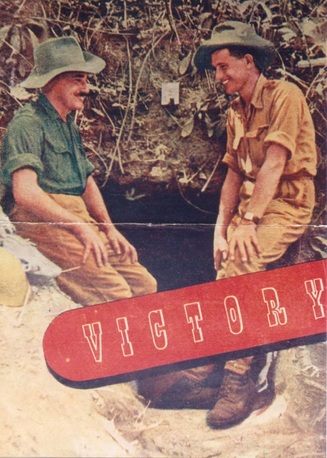
Hot off the heals of our VJ Day 2nd Suffolk image, came news from a Friend of a posting on Facebook of the image above of two Suffolk soldiers outside the entrance to their foxhole in the Arakan.
The image, which we suspect may have been coloured, was already known to us. It featured first featured in the May-June 1944 edition of the Regimental Gazette, under our title above, but was printed in black and white. This is the first time that we have seen it in colour, when it was reprinted in September 1945 as the front cover of "The Weekly for India Command" magazine.
We believe that this image was also published much earlier in an edition of ‘Parade’ Magazine in an article entitled ‘Men of The Arakan’ which featured Sgt Parr who was rumoured to have at that time, the longest moustache in the British Army! To see the image in colour is a real bonus. If the image has not been altered in any way, then it would prove that khaki drill and jungle green uniforms were worn together at the same time. It has always been assumed that 2nd Suffolk left their KD uniforms in India, and changed into JG when they went into Burma, but the man on the left, wears both!
Also, what mades this image extra special, is that the soldier on the right has been identified as Robert John Lambert, who originally started his service with Regiment in the 1st Battalion in 1941.
Images of the 2nd Battalion in the Far East are even rarer than those of the 1st Battalion in NW Europe, so it's great to see that 70 years on, they are still being uncovered. The 'Forgotten Army' of the far east are getting more and more well known every day!
(Posted: 20.08.2015)
The image, which we suspect may have been coloured, was already known to us. It featured first featured in the May-June 1944 edition of the Regimental Gazette, under our title above, but was printed in black and white. This is the first time that we have seen it in colour, when it was reprinted in September 1945 as the front cover of "The Weekly for India Command" magazine.
We believe that this image was also published much earlier in an edition of ‘Parade’ Magazine in an article entitled ‘Men of The Arakan’ which featured Sgt Parr who was rumoured to have at that time, the longest moustache in the British Army! To see the image in colour is a real bonus. If the image has not been altered in any way, then it would prove that khaki drill and jungle green uniforms were worn together at the same time. It has always been assumed that 2nd Suffolk left their KD uniforms in India, and changed into JG when they went into Burma, but the man on the left, wears both!
Also, what mades this image extra special, is that the soldier on the right has been identified as Robert John Lambert, who originally started his service with Regiment in the 1st Battalion in 1941.
Images of the 2nd Battalion in the Far East are even rarer than those of the 1st Battalion in NW Europe, so it's great to see that 70 years on, they are still being uncovered. The 'Forgotten Army' of the far east are getting more and more well known every day!
(Posted: 20.08.2015)
Photograph Of 2nd Suffolk Used For National VJ Day Celebrations
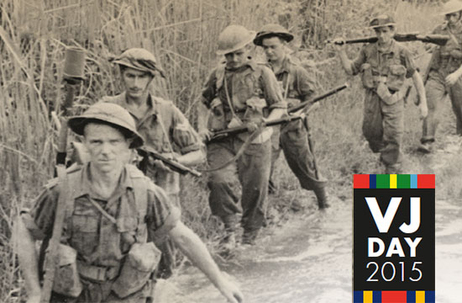
Over the last few days, The Suffolk Regiment have appeared prominently in the nations media in association with the 70th anniversary of VJ Day.
First, Friend Geoff Fleet spotted in Friday's edition of the Daily Telegraph, a photograph of a Suffolk soldier joining in with the festivities in Trafalgar Square in 1945. Although he wears no divisional insignia, his 'Suffolk' shoulder title and red and yellow 'Minden' flash are clearly visible in the photograph.
Then yesterday, we spotted that the national media campaign for the VJ Day celebrations in London, used as their main image, a photograph of men of 2nd Suffolk wading through a swamp in the Arakan in 1944.
Sadly there was no direct mention that either image containing men The Suffolk Regiment, but at least the Regiment's 'Old Dozen' who fought in the Pacific theatre, were not forgotten on the anniversary of the day the Second World War finally ended.
(Posted: 17/08/2015)
First, Friend Geoff Fleet spotted in Friday's edition of the Daily Telegraph, a photograph of a Suffolk soldier joining in with the festivities in Trafalgar Square in 1945. Although he wears no divisional insignia, his 'Suffolk' shoulder title and red and yellow 'Minden' flash are clearly visible in the photograph.
Then yesterday, we spotted that the national media campaign for the VJ Day celebrations in London, used as their main image, a photograph of men of 2nd Suffolk wading through a swamp in the Arakan in 1944.
Sadly there was no direct mention that either image containing men The Suffolk Regiment, but at least the Regiment's 'Old Dozen' who fought in the Pacific theatre, were not forgotten on the anniversary of the day the Second World War finally ended.
(Posted: 17/08/2015)
Leiston Pauses To Remember The 70th Anniversary of VJ Day
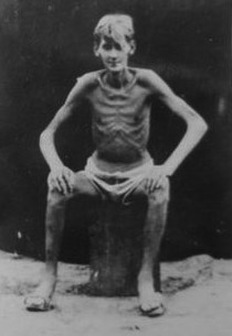
Today, the Friends were again at the Long Shop Museum in Leiston, to attend a short service of commemoration to remember the 70th anniversary of VJ Day (15th August 1945) which finally brought the Second World War to an end.
To the men of the 4th and 5th Battalions of The Suffolk Regiment, and the 1st and 2nd Battalions of The Cambridgeshire Regiment, VJ Day was a long time in the coming. Captured at Singapore in February 1942, the men of these Battalions were forced to first clean up Singapore itself, and then build a fifth airfield on the island, before being moved up into Malaya, and then Thailand, to build a Japanese railroad from Bangkok to Rangoon. It was hard work. The track which cut through virgin jungle, mountain range and solid rock, was laid by hand and by the end of the war, it was still unfinished, but for every sleeper laid, an allied prisoner died.
Today, the Director of the Museum, the Chairman of the local British Legion, a representative from the Town Council and a member of the Old Comrades Association, laid wreaths at the foot of a framed, sun-bleached Union flag that once graced the altar of the prisoners church in Chungkai camp, Thailand.
The flag, which was rescued after the VJ Day in 1945, was brought home to Leiston by Private Bailey and hung for many years in the Leiston TA Centre. However, in 1993, when it was getting frail, the local branch of the Old Comrades Association stepped in to have it framed and moved from the TA Centre to the Long Shop museum, who agreed to accept the flag on permanent loan.
One of the few surviving artefacts from that brutal period of captivity, the flag stands as a testament to all those from the 18th (East Anglian) division who died in captivity at the hands of the Japanese between 1942 and 1945 and who never returned home.
To watch the BBC coverage of the event, which included a short interview with the President of the Leiston Branch of the Old Comrades Association, John Richardson, please click onto link below:
http://www.bbc.co.uk/iplayer/episode/b064lvxb/look-east-east-15082015
(Posted: 15.08.2015)
To the men of the 4th and 5th Battalions of The Suffolk Regiment, and the 1st and 2nd Battalions of The Cambridgeshire Regiment, VJ Day was a long time in the coming. Captured at Singapore in February 1942, the men of these Battalions were forced to first clean up Singapore itself, and then build a fifth airfield on the island, before being moved up into Malaya, and then Thailand, to build a Japanese railroad from Bangkok to Rangoon. It was hard work. The track which cut through virgin jungle, mountain range and solid rock, was laid by hand and by the end of the war, it was still unfinished, but for every sleeper laid, an allied prisoner died.
Today, the Director of the Museum, the Chairman of the local British Legion, a representative from the Town Council and a member of the Old Comrades Association, laid wreaths at the foot of a framed, sun-bleached Union flag that once graced the altar of the prisoners church in Chungkai camp, Thailand.
The flag, which was rescued after the VJ Day in 1945, was brought home to Leiston by Private Bailey and hung for many years in the Leiston TA Centre. However, in 1993, when it was getting frail, the local branch of the Old Comrades Association stepped in to have it framed and moved from the TA Centre to the Long Shop museum, who agreed to accept the flag on permanent loan.
One of the few surviving artefacts from that brutal period of captivity, the flag stands as a testament to all those from the 18th (East Anglian) division who died in captivity at the hands of the Japanese between 1942 and 1945 and who never returned home.
To watch the BBC coverage of the event, which included a short interview with the President of the Leiston Branch of the Old Comrades Association, John Richardson, please click onto link below:
http://www.bbc.co.uk/iplayer/episode/b064lvxb/look-east-east-15082015
(Posted: 15.08.2015)
Ernie Guest 1932 - 2015
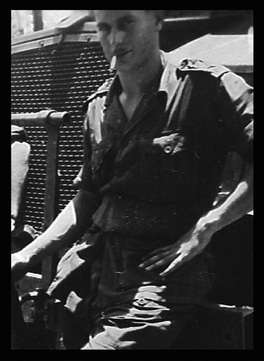
After such a successful Minden Day, it was with much sadness that we received news today from Tony Rogers of the Hemel Hempstead Branch of the Old Comrades Association, that their Chairman, Ernie Guest, had passed away after long battle with cancer.
Ernie served his National Service with The Suffolk Regiment between 1949 and 1954. After basic training, he was posted to join the 1st Battalion in Malaya. Most of his time there was spent serving with 8 Platoon, C Company, nicknamed the "Green Devils" alongside a close chum, Bill Price, who was later to be awarded the DCM.
In later life, Ernie, along with Tony Rogers, Dennis Levitt, Mike Gilbert and the late Ray Burdett, reincarnated their local Hemel branch of the OCA into a worldwide organisation with a membership of over 350. At its peak, it was the largest ever branch of the OCA. Through their actions, they kept The Suffolk Regiment alive when most others considered it dead.
An early Friends member, Ernie was a regular at the Diss Malaya dinners, John Blench's annual pig roasts and Minden Day. One of a now rapidly dwindling band of men who served in Malaya, he will be much missed.
Our thoughts are with his family and his old comrades at this difficult time.
(Posted: 05/08/2015)
Ernie served his National Service with The Suffolk Regiment between 1949 and 1954. After basic training, he was posted to join the 1st Battalion in Malaya. Most of his time there was spent serving with 8 Platoon, C Company, nicknamed the "Green Devils" alongside a close chum, Bill Price, who was later to be awarded the DCM.
In later life, Ernie, along with Tony Rogers, Dennis Levitt, Mike Gilbert and the late Ray Burdett, reincarnated their local Hemel branch of the OCA into a worldwide organisation with a membership of over 350. At its peak, it was the largest ever branch of the OCA. Through their actions, they kept The Suffolk Regiment alive when most others considered it dead.
An early Friends member, Ernie was a regular at the Diss Malaya dinners, John Blench's annual pig roasts and Minden Day. One of a now rapidly dwindling band of men who served in Malaya, he will be much missed.
Our thoughts are with his family and his old comrades at this difficult time.
(Posted: 05/08/2015)
Friend Martin Bell's New Book Officially Launched At Minden Day
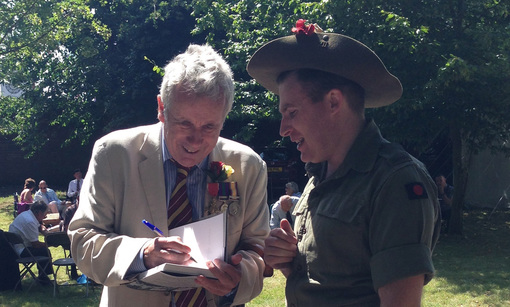
On Sunday, Martin Bell's new autobiography 'The End of Empire' was officially launched. The twenty copies that had been sent for sale in the Regimental Shop on Minden Day, quickly sold out, with many 1/Suffolk Cyprus veterans chasing the author around the Parade Ground for his autograph.
Based on the letters he sent home to his family whilst serving in Cyprus, Martin's book paints a vivid picture of The Suffolk Regiment on their last overseas posting before amalgamation from the viewpoint of a private soldier. Martin drew on many other previously unpublished sources including an embargoed volume entitled 'The Flaming Cassock' written by Suffolk officer, Lieutenant-Colonel Arthur Campbell, who had previously published a semi-factual account of the Malayan Emergency entitled 'Jungle Green.' The volume, written at the request of the then Governor of Cyprus, Field-Marshal Sir John Harding, was then suppressed by his successor, Sir Hugh Foot. To this day, Campbell's work lies buried deep in the National Archives.
Copies of the book are available to buy online and through many outlets and direct from the publisher, Pen and Sword. It is well worth a read and all proceeds from its sale have been donated to the Suffolk Regiment Combined Charity.
(Posted: 04/08/2015)
Based on the letters he sent home to his family whilst serving in Cyprus, Martin's book paints a vivid picture of The Suffolk Regiment on their last overseas posting before amalgamation from the viewpoint of a private soldier. Martin drew on many other previously unpublished sources including an embargoed volume entitled 'The Flaming Cassock' written by Suffolk officer, Lieutenant-Colonel Arthur Campbell, who had previously published a semi-factual account of the Malayan Emergency entitled 'Jungle Green.' The volume, written at the request of the then Governor of Cyprus, Field-Marshal Sir John Harding, was then suppressed by his successor, Sir Hugh Foot. To this day, Campbell's work lies buried deep in the National Archives.
Copies of the book are available to buy online and through many outlets and direct from the publisher, Pen and Sword. It is well worth a read and all proceeds from its sale have been donated to the Suffolk Regiment Combined Charity.
(Posted: 04/08/2015)
Another Great Minden Day
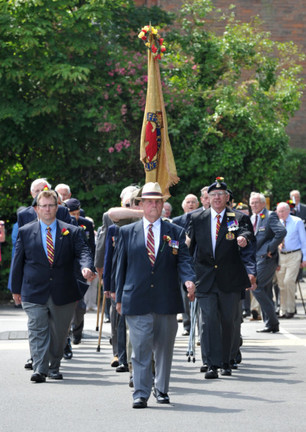
Another great 'Minden Day' has come and gone. 56 years after their amalgamation with the Royal Norfolk Regiment, the massed ranks of the Suffolk Regiment Old Comrades Association assembled once more at Gibraltar Barracks, Bury St Edmunds on 2nd August to celebrate the Regiment's most famous Battle Honour, to meet old chums and recount campaigns past.
Those well enough to march numbered almost one hundred with friends from Cambridgeshire, Norfolk, Essex and Hertfordshire joining them on parade.
Though this number may seem small, the spirit was still high and the parade showed that for many more years to come, The Suffolk Regiment is still very much alive and well.
Read the Bury Free Press's fantastic account of the days proceedings here:
http://www.buryfreepress.co.uk/news/local/latest-news/old-comrades-return-to-barracks-to-mark-300th-anniversary-of-minden-1-6883768
"Stabilis"
(photo courtesy of the Bury Free Press)
(Posted 02/08/2015)
Those well enough to march numbered almost one hundred with friends from Cambridgeshire, Norfolk, Essex and Hertfordshire joining them on parade.
Though this number may seem small, the spirit was still high and the parade showed that for many more years to come, The Suffolk Regiment is still very much alive and well.
Read the Bury Free Press's fantastic account of the days proceedings here:
http://www.buryfreepress.co.uk/news/local/latest-news/old-comrades-return-to-barracks-to-mark-300th-anniversary-of-minden-1-6883768
"Stabilis"
(photo courtesy of the Bury Free Press)
(Posted 02/08/2015)
Happy Minden Day!
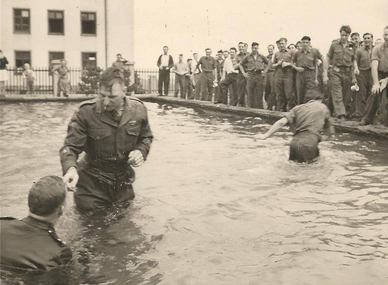
A Very Happy Minden Day to all Friends.
Join with us today in celebrating The Suffolk Regiment's most famous Battle Honour. Traditionally, Minden Day was a day of celebration within The Suffolk Regiment. There was normally a formal parade, followed by games, a dance, and much beer!
Just this morning via the Friends Facebook page, Mark Mobius sent us this photograph, from the album of his father who served with 1/Suffolk, of the Minden Day frivolities 60 years when the 1st Battalion were stationed at Harding Barracks, Wuppertal, as part of the British Army of the Rhine (BAOR).
The photograph (which has for many years been heavily embargoed!) shows the revered and venerated figure of RSM H.J. Gingell, being thrown into the emergency water pool by Lieutenant Bob Godfrey as part of the Minden Day festivities. Sadly for Bob, he went in the drink shortly after the RSM!!
So wear today your red and yellow roses with pride and remember all those of the the old 12th of Foot who on 1st August 1759 defeated the French at Minden and gained the Regiment his most prestigious Battle Honour.
(Posted: 01/08/2015)
Join with us today in celebrating The Suffolk Regiment's most famous Battle Honour. Traditionally, Minden Day was a day of celebration within The Suffolk Regiment. There was normally a formal parade, followed by games, a dance, and much beer!
Just this morning via the Friends Facebook page, Mark Mobius sent us this photograph, from the album of his father who served with 1/Suffolk, of the Minden Day frivolities 60 years when the 1st Battalion were stationed at Harding Barracks, Wuppertal, as part of the British Army of the Rhine (BAOR).
The photograph (which has for many years been heavily embargoed!) shows the revered and venerated figure of RSM H.J. Gingell, being thrown into the emergency water pool by Lieutenant Bob Godfrey as part of the Minden Day festivities. Sadly for Bob, he went in the drink shortly after the RSM!!
So wear today your red and yellow roses with pride and remember all those of the the old 12th of Foot who on 1st August 1759 defeated the French at Minden and gained the Regiment his most prestigious Battle Honour.
(Posted: 01/08/2015)
Friends Put '1 Suffolk & D-Day' Back Into Print After 25 Years
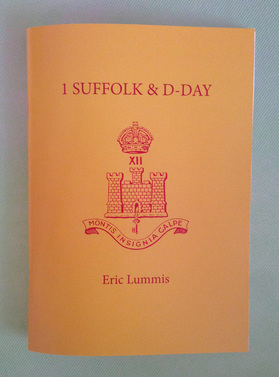
Hot off the press, the Friends are very pleased to announce that Lieutenant-Colonel Eric Lummis's seminal work on the 1st Battalion's role on D-Day is now back in print and available for sale once more.
In 1989 following the second official pilgrimage by the former members of 1/Suffolk to the Normandy battlefields, Lieutenant-Colonel Eric Lummis; himself a D-Day veteran, published the first definitive account of the actions of the Battalion that day. Drawing on the recollections of whose were there, combined with many first-hand, unpublished accounts, his work has remained the seminal account of 1/Suffolk on D-Day.
To the best of our knowledge, just one printing was made of his booklet. A small addendum was added as a slip-in sheet in 1994, correcting a few spelling mistakes and misspelt names, but as copies gradually sold out in the Regimental Shop, the need to reprint Eric's work became of paramount urgency. There was however a problem.
Eric's work was originally a black and white, carbon copied, typewritten booklet, published long before the advent of digital publishing. With no master file, the Friends stepped in to transcribe Eric's original text and convert it into an electronic format.
Today, 26 years on, the Booklet is back in print along with a special anniversary epilogue and will be available to buy from the Regimental Shop this Sunday on Minden Day and then online via the Suffolk Regiment Museum website.
(Posted: 31.07.2015)
In 1989 following the second official pilgrimage by the former members of 1/Suffolk to the Normandy battlefields, Lieutenant-Colonel Eric Lummis; himself a D-Day veteran, published the first definitive account of the actions of the Battalion that day. Drawing on the recollections of whose were there, combined with many first-hand, unpublished accounts, his work has remained the seminal account of 1/Suffolk on D-Day.
To the best of our knowledge, just one printing was made of his booklet. A small addendum was added as a slip-in sheet in 1994, correcting a few spelling mistakes and misspelt names, but as copies gradually sold out in the Regimental Shop, the need to reprint Eric's work became of paramount urgency. There was however a problem.
Eric's work was originally a black and white, carbon copied, typewritten booklet, published long before the advent of digital publishing. With no master file, the Friends stepped in to transcribe Eric's original text and convert it into an electronic format.
Today, 26 years on, the Booklet is back in print along with a special anniversary epilogue and will be available to buy from the Regimental Shop this Sunday on Minden Day and then online via the Suffolk Regiment Museum website.
(Posted: 31.07.2015)
Will Longstaff's 'Menin Gate at Midnight' Returns To Ypres
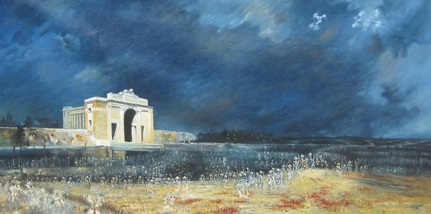
88 years after it was originally painted, Will Longstaff's epic canvas entitled "The Menin Gate at Midnight" will be displayed in the town it depicts. Longstaff, an Australian painter, captured the image of the newly unveiled monument with ghostly aries marching past following the official opening on 24th July 1927.
Pictured in the "Graphic" in December that year, it received immediate acclaim and was promptly purchased by Lord Woolavington who donated it to the Government of Australia in 1928. However, what I hear you say, has this to do with the Suffolk Regiment? well...Longstaff also painted the only known painting of the Suffolk Regiment in action in Salonika during the Great War. The painting (below) which depicts a counter attack on the 1st Battalion in the Struma Valley in October 1916, originally hung in the Officers Mess of the 1st Battalion, but since amalgamation, its whereabouts are at present unknown.
If you know of its current location, we'd like to hear from you since with the centenary of the 1st Battalion departing for Salonika, we'd really like to write an article on to for a forthcoming magazine.
(Posted: 26/07/2015)
Pictured in the "Graphic" in December that year, it received immediate acclaim and was promptly purchased by Lord Woolavington who donated it to the Government of Australia in 1928. However, what I hear you say, has this to do with the Suffolk Regiment? well...Longstaff also painted the only known painting of the Suffolk Regiment in action in Salonika during the Great War. The painting (below) which depicts a counter attack on the 1st Battalion in the Struma Valley in October 1916, originally hung in the Officers Mess of the 1st Battalion, but since amalgamation, its whereabouts are at present unknown.
If you know of its current location, we'd like to hear from you since with the centenary of the 1st Battalion departing for Salonika, we'd really like to write an article on to for a forthcoming magazine.
(Posted: 26/07/2015)
Paul 'Spider' Webb
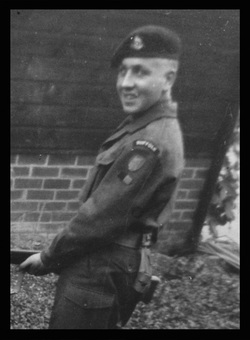
It was with much sadness that we learned today of the passing of Paul Webb, formerly of The Suffolk Regiment who served in Cyprus and later as a Regimental Policeman at the Depot.
Paul, like many of his generation, was a National Serviceman, who following his basic training at Blenheim Camp, was posted to the 1st Battalion; then stationed at Xeros Camp, Cyprus.
Paul never lost contact with the Regiment. In later life, Paul was a loyal member of the Ipswich Branch of the Old Comrades Association and was a regular at Minden Day and at the annual Service of Remembrance in Ipswich every year.
Our thoughts are with his widow Irene, and his family at this difficult time.
(Posted: 14/07/2015)
Paul, like many of his generation, was a National Serviceman, who following his basic training at Blenheim Camp, was posted to the 1st Battalion; then stationed at Xeros Camp, Cyprus.
Paul never lost contact with the Regiment. In later life, Paul was a loyal member of the Ipswich Branch of the Old Comrades Association and was a regular at Minden Day and at the annual Service of Remembrance in Ipswich every year.
Our thoughts are with his widow Irene, and his family at this difficult time.
(Posted: 14/07/2015)
Major Ron Rogers Awarded The Legion d'Honneur
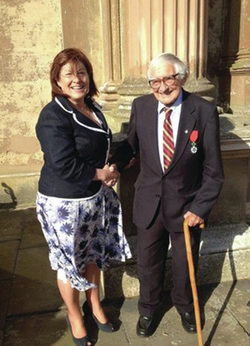
We are delighted to announce that Major Ron Rogers, formerly of 1/Suffolk, has been awarded the Legion d'Honneur by the French nation in grateful recognition of the part he played during the D-Day landings.
A decision made last year by the French government, saw the awarding of the Legion d'Honour to all surviving veterans who took part in the D-Day landings in June 1944 and on Wednesday 17th June, Ron was presented with his medal by HM Lord Lieutenant of Bedfordshire, Helen Nellis at Turvey House near Bedford.
Ron landed on D-Day as second in command of A Company and assumed command after the death of its commander, Captain R.G. Ryley, and his replacement, Major Eric Lummis. Ron was later wounded by a mortar bomb on the 13th August 1944, when the Battalion were attacking along the Vire-Tinchebrai road. Invalided out of battle, he recovered from his injuries rejoining the Battalion in Holland in January 1945.
On behalf of all Friends, we congratulate Ron on his award; the first to be presented a member of The Suffolk Regiment for over 70 years.
(Originally Posted: 19/06/2015)
A decision made last year by the French government, saw the awarding of the Legion d'Honour to all surviving veterans who took part in the D-Day landings in June 1944 and on Wednesday 17th June, Ron was presented with his medal by HM Lord Lieutenant of Bedfordshire, Helen Nellis at Turvey House near Bedford.
Ron landed on D-Day as second in command of A Company and assumed command after the death of its commander, Captain R.G. Ryley, and his replacement, Major Eric Lummis. Ron was later wounded by a mortar bomb on the 13th August 1944, when the Battalion were attacking along the Vire-Tinchebrai road. Invalided out of battle, he recovered from his injuries rejoining the Battalion in Holland in January 1945.
On behalf of all Friends, we congratulate Ron on his award; the first to be presented a member of The Suffolk Regiment for over 70 years.
(Originally Posted: 19/06/2015)
Airspeed's Historic Home Set For Demolition
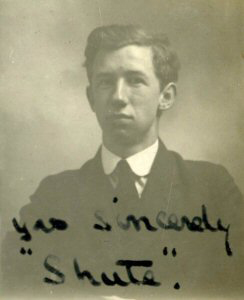
An historic garage in York is set for demolition as its condition has deteriorated to such an extent that the city council now deem it an "inherent risk to life and limb."
The garage situated in Picadilly, York, was the first home for Airspeed Limited, the pioneering British aviation company famous for such aircraft as the Airspeed Oxford, and later, the Airspeed Horsa - the wooden glider that played a pivotal role during D-Day and later at Arnhem. However, what is less known, is that one of Airspeed's founders, was the aviation engineer and later novelist, Nevil Shute.
Interested in aviation from an early age, Shute was unable to obtain a commission in the Royal Flying Corps during the Great War, and instead, enlisted in 1918 as a private in the 1st (Reserve Garrison) Battalion, The Suffolk Regiment, then stationed on the Isle of Grain in the Thames Estuary. The Battalion at that time also contained another young private who was also to go onto greater things; the conductor Sir John Barbirolli.
Nevil Shute Norway, famous for his books such as 'A Town Like Alice' and 'Slide Rule' started the company in 1931 with his colleague Alfred Tillman after a illustrious career with both de Havilland and Vickers - where he had helped design the R100 airship.
During the Second World War Shute turned his talents to work on experimental weapons designing amongst others, the not so successful 'giant panjandrum' - a revolving rocket-powered Catherine wheel.
Identified as a "building of merit" the Airspeed factory would require a minimum of £95,000 to be spent upon it to make it stable, but it has already been suggested that it should be preserved as a museum to the important part that York played in the British aviation industry.
Please visit the website below for more information on the options for its preservation and while you're there, complete the online poll. So far, 71% of online votes are in favour of saving this historic aviation landmark.
http://www.yorkmix.com/news/historic-york-garage-and-former-aircraft-factory-set-to-be-demolished/
(Posted: 18/06/2015)
The garage situated in Picadilly, York, was the first home for Airspeed Limited, the pioneering British aviation company famous for such aircraft as the Airspeed Oxford, and later, the Airspeed Horsa - the wooden glider that played a pivotal role during D-Day and later at Arnhem. However, what is less known, is that one of Airspeed's founders, was the aviation engineer and later novelist, Nevil Shute.
Interested in aviation from an early age, Shute was unable to obtain a commission in the Royal Flying Corps during the Great War, and instead, enlisted in 1918 as a private in the 1st (Reserve Garrison) Battalion, The Suffolk Regiment, then stationed on the Isle of Grain in the Thames Estuary. The Battalion at that time also contained another young private who was also to go onto greater things; the conductor Sir John Barbirolli.
Nevil Shute Norway, famous for his books such as 'A Town Like Alice' and 'Slide Rule' started the company in 1931 with his colleague Alfred Tillman after a illustrious career with both de Havilland and Vickers - where he had helped design the R100 airship.
During the Second World War Shute turned his talents to work on experimental weapons designing amongst others, the not so successful 'giant panjandrum' - a revolving rocket-powered Catherine wheel.
Identified as a "building of merit" the Airspeed factory would require a minimum of £95,000 to be spent upon it to make it stable, but it has already been suggested that it should be preserved as a museum to the important part that York played in the British aviation industry.
Please visit the website below for more information on the options for its preservation and while you're there, complete the online poll. So far, 71% of online votes are in favour of saving this historic aviation landmark.
http://www.yorkmix.com/news/historic-york-garage-and-former-aircraft-factory-set-to-be-demolished/
(Posted: 18/06/2015)
Waterloo 200
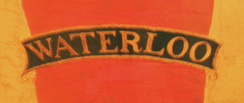
Today is the 200th anniversary of the Battle of Waterloo when in 1815, the reign of Napoleon Bonaparte was brought to an end. The 12th Regiment however took no part in the battle. They were in fact miles from the French battlefield on the island of Mauritius. They had recently vacated the neighbouring island of Bourbon which has only months before Waterloo, been returned to French control.
The only part of the Suffolk Regiment to have any tenuous link to the great battle were the 2nd Battalion, who were immediately after the battle, were sent from their station on the Isle of Wight, to Paris for garrison duties, arriving there on 5th July.
The Battalion's single claim to fame in this momenteous year was that they inadvertently stumbled across the Emperors wine cellar in Montmartre and it was said that for a period of nearly six weeks, the entire Battalion was in a permanent state of intoxication! One Suffolk soldiers wife, Molly Ryan, made such wealth from serving the soldiers the Emperors liberated liquor, that she returned to Ireland and brought a sizeable farm with her profits.
Spare a thought today for the men of Wellington's armies who, 200 years ago, finally defeated Napoleon and brought to an end his reign of tyranny in Europe.
(Posted: 18/06/2015)
The only part of the Suffolk Regiment to have any tenuous link to the great battle were the 2nd Battalion, who were immediately after the battle, were sent from their station on the Isle of Wight, to Paris for garrison duties, arriving there on 5th July.
The Battalion's single claim to fame in this momenteous year was that they inadvertently stumbled across the Emperors wine cellar in Montmartre and it was said that for a period of nearly six weeks, the entire Battalion was in a permanent state of intoxication! One Suffolk soldiers wife, Molly Ryan, made such wealth from serving the soldiers the Emperors liberated liquor, that she returned to Ireland and brought a sizeable farm with her profits.
Spare a thought today for the men of Wellington's armies who, 200 years ago, finally defeated Napoleon and brought to an end his reign of tyranny in Europe.
(Posted: 18/06/2015)
Breach, Merideth, Garnham or Dodd?
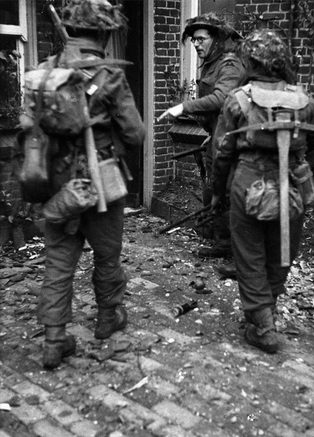
Despite eleven months of hard campaigning, there is only a
very small amount of surviving photographs of 1/Suffolk taken during the campaign
in NW Europe – in fact less than 70 known images. It's therefore a great day when we
find another unknown image of the Battalion in action during these months. Yesterday was just such a day when the image left, was discovered on a Dutch
archive website.
The image shows an officer of 1/Suffolk on the advance through a Dutch farmhouse with a Bren gun team during the final phases of the battle of Overloon on 18th October 1944.
Having viewed the photograph in as bigger detail as possible, the length of the shoulder title indicated that he is a member of 1/Suffolk (1st South Lancs and 2nd East Yorks having longer shoulder titles). with all men having a single 'arm-of-service strip' indicating they are all members of 8th Brigade.
The photograph is a true snapshot in time, taken in the heat of battle. The men, grimy from battle, stand amidst the wreckage of attack including the tailfins of many 2" mortar bombs. The men have their GS caps tucked under the flaps of their packs and both carry a pick; commonly seen with assaulting troops. The section commander in the centre - visible by the pips on his epaulettes, carries a Mk. III Sten gun - a popular weapon for officers and section commanders. The man left appears to have either a first aid satchel or a radio set spares bag slung over one shoulder, whilst the man on the right has his light weight respirator bag (most probably without the mask) slung off his string lanyard around his waist.
The officer was it was first believed, to be Major John Duxbury, who joined 1/Suffolk in Normandy but after further research, it has been discovered that he was wounded on the Vire-Tinchebrai road on 13th August 1944 whilst in command of B Company. Therefore he would have been in hospital when this photo is believed to have been taken.
A further possibility as to the identity of the officer is Captain Francis Dodd, who was with C Company at the time and was wounded in shoulder at Overloon on 18th - possibly just before this image was taken.
Bespectacled officers were rare in 1/Suffolk. Captain Nat Breach wore a pair of thick glasses, as did young subaltern Ray Merideth, as did Ron Garnham, but he was wounded on 19th July and did not return to the Battalion until January 1945. Personally, my money is on Dodd but if anyone could confirm (or deny) the identity of the unknown Suffolk officer, please do get in contact with us.
(Posted: 15.06.2015)
The image shows an officer of 1/Suffolk on the advance through a Dutch farmhouse with a Bren gun team during the final phases of the battle of Overloon on 18th October 1944.
Having viewed the photograph in as bigger detail as possible, the length of the shoulder title indicated that he is a member of 1/Suffolk (1st South Lancs and 2nd East Yorks having longer shoulder titles). with all men having a single 'arm-of-service strip' indicating they are all members of 8th Brigade.
The photograph is a true snapshot in time, taken in the heat of battle. The men, grimy from battle, stand amidst the wreckage of attack including the tailfins of many 2" mortar bombs. The men have their GS caps tucked under the flaps of their packs and both carry a pick; commonly seen with assaulting troops. The section commander in the centre - visible by the pips on his epaulettes, carries a Mk. III Sten gun - a popular weapon for officers and section commanders. The man left appears to have either a first aid satchel or a radio set spares bag slung over one shoulder, whilst the man on the right has his light weight respirator bag (most probably without the mask) slung off his string lanyard around his waist.
The officer was it was first believed, to be Major John Duxbury, who joined 1/Suffolk in Normandy but after further research, it has been discovered that he was wounded on the Vire-Tinchebrai road on 13th August 1944 whilst in command of B Company. Therefore he would have been in hospital when this photo is believed to have been taken.
A further possibility as to the identity of the officer is Captain Francis Dodd, who was with C Company at the time and was wounded in shoulder at Overloon on 18th - possibly just before this image was taken.
Bespectacled officers were rare in 1/Suffolk. Captain Nat Breach wore a pair of thick glasses, as did young subaltern Ray Merideth, as did Ron Garnham, but he was wounded on 19th July and did not return to the Battalion until January 1945. Personally, my money is on Dodd but if anyone could confirm (or deny) the identity of the unknown Suffolk officer, please do get in contact with us.
(Posted: 15.06.2015)
BBC Look East Visits The Suffolk Regiment Museum
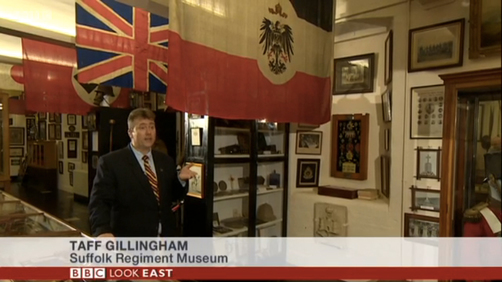
Tonight on the BBC Look East news, presenter Shaun Peel was shown around the superb Suffolk Regiment Museum by our very own Taff Gillingham who explained the stories behind just a few of the amazing treasures it contains.
The German Flag captured from the Governors residence in Togoland in August 1914 - almost certainly the first real "souvenir" of the Great War, was shown, along with the Regimental Silver including the "Currey Cup" - named after Captain Vere-Fortrey Currey, killed in action at Loos whilst attacking "Hair-pin" trench on 13th October 1915.
Captain Harvey P. Frost's Burberry mackintosh "holed by a whiff of shrapnel" and his original P-Type gas helmet - worn during the gas attack at St. Jean on 19th December 1915, were also seen along with many other amazing gems from the Regiment's proud 274 year history.
The last of its kind anywhere in the country, The Suffolk Regiment Museum is still an unknown and untouched gem in the heart of Suffolk. Now in its 80th year and still going strong - why not visit it to discover its many treasures!
You can watch the programme online for 24 hours or download it to view for the next 30 days via the BBC player. It can be found here: (the article starts at around 21:35):
http://www.bbc.co.uk/…/epi…/b05vsf8b/look-east-east-01062015
Well done Taff!
(Posted: 01/06/2015)
The German Flag captured from the Governors residence in Togoland in August 1914 - almost certainly the first real "souvenir" of the Great War, was shown, along with the Regimental Silver including the "Currey Cup" - named after Captain Vere-Fortrey Currey, killed in action at Loos whilst attacking "Hair-pin" trench on 13th October 1915.
Captain Harvey P. Frost's Burberry mackintosh "holed by a whiff of shrapnel" and his original P-Type gas helmet - worn during the gas attack at St. Jean on 19th December 1915, were also seen along with many other amazing gems from the Regiment's proud 274 year history.
The last of its kind anywhere in the country, The Suffolk Regiment Museum is still an unknown and untouched gem in the heart of Suffolk. Now in its 80th year and still going strong - why not visit it to discover its many treasures!
You can watch the programme online for 24 hours or download it to view for the next 30 days via the BBC player. It can be found here: (the article starts at around 21:35):
http://www.bbc.co.uk/…/epi…/b05vsf8b/look-east-east-01062015
Well done Taff!
(Posted: 01/06/2015)
Cambridgeshire Recruiting Film Released By The EAFA
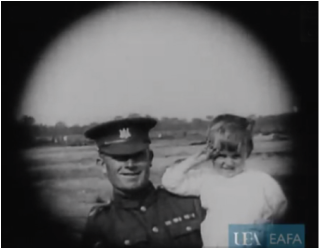
Today we received news that the East Anglian Film Archive have just released online, a truly great little film from the Cambridgeshire Regiment's annual camp in 1921.
The film, which was designed to bolster numbers in the Regiments ranks, would have been shown in cinemas across Cambridgeshire.
It features a day in the life of the Territorial Army showing such highlights as the Bugler sounding Reveille, the Cook preparing lunch and then getting a beer in! Regimental sports and an inspection by the CO, Lieutenant-Colonel M.C. Clayton and Major-General S.W. Hare, who commanded the 54th (East Anglian) Division in the Middle East during the war.
The screen capture above was entitled "A Future Territorial" and appears to show Sgt. Tant Hilliam with his young daughter. The short 6 minute film can be seen at the following address: http://www.archivealive.org/video/index/id/228
(Posted: 19/05/2015)
The film, which was designed to bolster numbers in the Regiments ranks, would have been shown in cinemas across Cambridgeshire.
It features a day in the life of the Territorial Army showing such highlights as the Bugler sounding Reveille, the Cook preparing lunch and then getting a beer in! Regimental sports and an inspection by the CO, Lieutenant-Colonel M.C. Clayton and Major-General S.W. Hare, who commanded the 54th (East Anglian) Division in the Middle East during the war.
The screen capture above was entitled "A Future Territorial" and appears to show Sgt. Tant Hilliam with his young daughter. The short 6 minute film can be seen at the following address: http://www.archivealive.org/video/index/id/228
(Posted: 19/05/2015)
8th May; Tragedy & Joy For 1st Suffolk
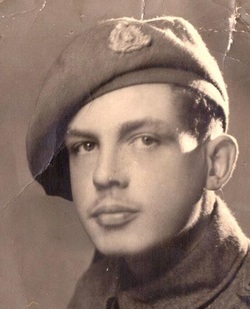
On Friday, the Nation celebrated the 70th anniversary of VE Day; the official end date to the war in Europe in 1945.
Whilst it was a day of celebration in many parts of the country, the Friends were on the Frezenberg Ridge near the Belgian city of Ypres, where 100 years ago on 8th May 1915, the 1st Battalion were taking a severe pounding by German artillery and poisoned gas in the opening stages of the Second Battle of Ypres.
The preceding days and the battle that day, destroyed the old 1st Battalion, leaving only 3 officers and 27 other ranks remaining alive and not in enemy hands.
Thirty years later, 1st Suffolk were again fighting a Germany enemy but unlike the 1st Battalion of 1915, who would be reformed and fight on, for 1st Suffolk in 1945, their fight had just ended. By January 1945, only the 1st Battalion were fighting in Europe. The 7th Battalion had been disbanded the previous January in Italy and the 2nd Battalion were still fighting in the Burmese jungles. 4th and 5th Suffolk, along with 1st and 2nd Cambridgeshires, were still in captivity in the Far East so for them there were no celebrations, just a further agonising wait until their victory was delivered.
Spare a thought for all those of both world wars who paid the ultimate price and in particular 5825867, Corporal Ernie Fountain; the last Suffolk soldier to die in North West Europe, killed accidentally when his Sten gun was knocked from the back of his chair in a cafe in Bremen on 4th May 1945.
(Posted: 10/05/2015)
Whilst it was a day of celebration in many parts of the country, the Friends were on the Frezenberg Ridge near the Belgian city of Ypres, where 100 years ago on 8th May 1915, the 1st Battalion were taking a severe pounding by German artillery and poisoned gas in the opening stages of the Second Battle of Ypres.
The preceding days and the battle that day, destroyed the old 1st Battalion, leaving only 3 officers and 27 other ranks remaining alive and not in enemy hands.
Thirty years later, 1st Suffolk were again fighting a Germany enemy but unlike the 1st Battalion of 1915, who would be reformed and fight on, for 1st Suffolk in 1945, their fight had just ended. By January 1945, only the 1st Battalion were fighting in Europe. The 7th Battalion had been disbanded the previous January in Italy and the 2nd Battalion were still fighting in the Burmese jungles. 4th and 5th Suffolk, along with 1st and 2nd Cambridgeshires, were still in captivity in the Far East so for them there were no celebrations, just a further agonising wait until their victory was delivered.
Spare a thought for all those of both world wars who paid the ultimate price and in particular 5825867, Corporal Ernie Fountain; the last Suffolk soldier to die in North West Europe, killed accidentally when his Sten gun was knocked from the back of his chair in a cafe in Bremen on 4th May 1945.
(Posted: 10/05/2015)
Remembering Gallipoli - 100 Years Ago
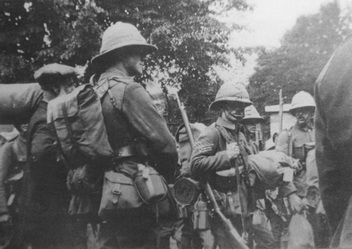
100 years ago, the Allied attack upon the Gallipoli peninsular began.
In an Allied coalition, British and French troops, along with Dominion troops from Australia and New Zealand landed on the Gallipoli peninsular in an attempt to make a lightening dash for Constantinople and knock Turkey and the Ottoman Empire out of the war.
In two separate landings on 25th April, a force of the Australian and New Zealand Army Corps (the ANZAC's) landed to the north, whilst a British landing was made to the south. Although the initial advance was deep, in some places to a distance of 3 miles was gained within 48 hours, the advance rapidly ground to a halt in the face of strong Turkish opposition.
Rapidly the two sides entered into a medieval troglodyte war, with a curious 'live and let live' mentality between the Turks and Allies. In places, the two sides even indulged in target practice with one another across the short distance between their trenches. A major offensive in early August failed to gain any ground and even with the arrival of fresh troops from England on 8th August - including the 54th (East Anglian) Division, of which 1/5th Suffolk were a part, the campaign was going nowhere and by late 1915, it was clear that no further advance could be made and that a withdrawal of troops was the only course of action. An evacuation was planned for early 1916 and by 8th January, the last men were leaving the battle front.
The campaign had achieved little strategically, but it had the grim days of 1915, given the British public, a sense of real achievement and the glimmer of an allied victory for 1915. The Commander of the Mediterranean Expeditionary Force, upon whose conscience the campaign weighed, was himself a former Suffolk soldier. General Sir Ian Hamilton started his career in the 12th Regiment in 1871.
Spare a thought today for those men of the 5th Battalion who landed on 8th August, and those men of the Loyal Suffolk Hussars who landed on 10th October, to take the fight to 'Johnny Turk'
(Posted: 25/04/2015)
In an Allied coalition, British and French troops, along with Dominion troops from Australia and New Zealand landed on the Gallipoli peninsular in an attempt to make a lightening dash for Constantinople and knock Turkey and the Ottoman Empire out of the war.
In two separate landings on 25th April, a force of the Australian and New Zealand Army Corps (the ANZAC's) landed to the north, whilst a British landing was made to the south. Although the initial advance was deep, in some places to a distance of 3 miles was gained within 48 hours, the advance rapidly ground to a halt in the face of strong Turkish opposition.
Rapidly the two sides entered into a medieval troglodyte war, with a curious 'live and let live' mentality between the Turks and Allies. In places, the two sides even indulged in target practice with one another across the short distance between their trenches. A major offensive in early August failed to gain any ground and even with the arrival of fresh troops from England on 8th August - including the 54th (East Anglian) Division, of which 1/5th Suffolk were a part, the campaign was going nowhere and by late 1915, it was clear that no further advance could be made and that a withdrawal of troops was the only course of action. An evacuation was planned for early 1916 and by 8th January, the last men were leaving the battle front.
The campaign had achieved little strategically, but it had the grim days of 1915, given the British public, a sense of real achievement and the glimmer of an allied victory for 1915. The Commander of the Mediterranean Expeditionary Force, upon whose conscience the campaign weighed, was himself a former Suffolk soldier. General Sir Ian Hamilton started his career in the 12th Regiment in 1871.
Spare a thought today for those men of the 5th Battalion who landed on 8th August, and those men of the Loyal Suffolk Hussars who landed on 10th October, to take the fight to 'Johnny Turk'
(Posted: 25/04/2015)
"The Accepted Replacement"
From a source close to the Regimental Museum, we have learnt that our publications, the Castle & Key and the Gazette, have been accepted as "the natural replacement" for the old Regimental newsletter; the Britannia and Castle, which sadly ceased publication last year, after recording the activities of The Regiment for almost 55 years.
We are very honoured to have been given such an accolade and we will do our best to continue to record the history and traditions of The Suffolk Regiment, for many more years to come. The spirit of the old Suffolk Regimental Gazette, which started in India over 125 years ago, still lives on thanks to the Friends.
(Posted: 17/04/2015)
We are very honoured to have been given such an accolade and we will do our best to continue to record the history and traditions of The Suffolk Regiment, for many more years to come. The spirit of the old Suffolk Regimental Gazette, which started in India over 125 years ago, still lives on thanks to the Friends.
(Posted: 17/04/2015)
Remembering Stan "Scotty" Scott
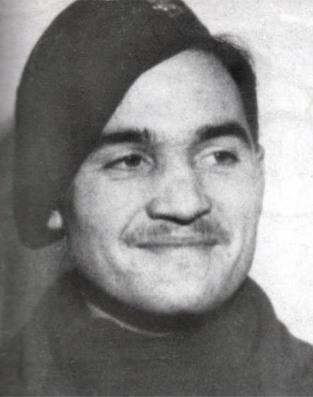
Today at the Commando Memorial at Spean Bridge near Fort William, Scotland, a special service was held to remember Army Commando Stan Scott, late of The Suffolk Regiment who died last June.
"Scotty" enlisted under age but was soon discovered. He was transferred to the 70th (Young Soldiers) Battalion of The Suffolk Regiment (No. 5835939) before being transferred to the Queen's Royal Regiment, where his father was serving. Shortly after initial training, he volunteered for service with the Commando's, joining No. 3 Troop in 1943.
Landing on D-Day with No. 3 Commando, the unit were only yards from some of Scotty's old comrades in The Suffolk Regiment as they began their assault on the bunker complex known as 'Hillman.' No. 3 Commando were the first Allied Forces to reach Major Howard and his men of 2/Ox & Bucks, who were holding onto the bridge over the Orne river, having landed by glider the previous night.
In 2008 Neil Barber published Scotty's memoirs in the best selling book "Fighting With The Commandos." He was a founder member of the Commando Veterans Association and was since its formation, its Chairman. A man who gave his life to the Army and later the Cadet Force, he started what was to become a legendary military career in The Suffolk Regiment.
(Posted: 11/04/2015)
"Scotty" enlisted under age but was soon discovered. He was transferred to the 70th (Young Soldiers) Battalion of The Suffolk Regiment (No. 5835939) before being transferred to the Queen's Royal Regiment, where his father was serving. Shortly after initial training, he volunteered for service with the Commando's, joining No. 3 Troop in 1943.
Landing on D-Day with No. 3 Commando, the unit were only yards from some of Scotty's old comrades in The Suffolk Regiment as they began their assault on the bunker complex known as 'Hillman.' No. 3 Commando were the first Allied Forces to reach Major Howard and his men of 2/Ox & Bucks, who were holding onto the bridge over the Orne river, having landed by glider the previous night.
In 2008 Neil Barber published Scotty's memoirs in the best selling book "Fighting With The Commandos." He was a founder member of the Commando Veterans Association and was since its formation, its Chairman. A man who gave his life to the Army and later the Cadet Force, he started what was to become a legendary military career in The Suffolk Regiment.
(Posted: 11/04/2015)
Remembering 'The Terriers'
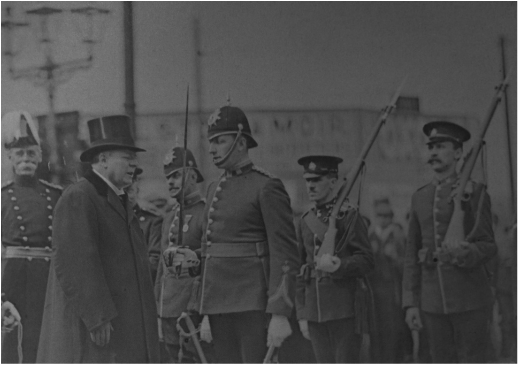
For those of you who have been following Operation Legacy, you will have read that 100 years ago, the 4th (Territorial) Battalion of The Suffolk Regiment were fighting in their first major engagement of the Great War at Neuve Chapelle.
The Battalion however traced its origins back a further seven years to when, on 1st April 1908, the old Militia and Volunteer Battalions of The Suffolk Regiment were disbanded, and two new Territorial Battalion's were created in their place.
By 1908, a formal reorganization of Britain’s volunteer soldiers was badly needed. Every single county had an administrative body looking after its own affairs. Every single unit had a different style of dress and different types of weaponry. If emergency arose, the chances of maintaining the supply of equipment and ammunition for all these different units, would be an impossibility.
Thus, at the insistence of Sir Joseph Lyons, the then Deputy Lieutenant of the County of London, later to become famous for his chain of cafes; the Lyons Corner Houses, the then Secretary of State for War, Sir Richard Burdon Haldane, created the "Territorial and Reserve Forces Act" in 1907 and began in 1908, the reorganisation of the plethora of volunteer units around the country. Known as the “Territorial Force” these new battalions were now officially affiliated to their regular counterparts and came under their wing for administration and training.
By 1920, with the Great War behind them, the Territorial Force was to be renamed the "Territorial Army" and would remain as such until recent memory when it was renamed the “Army Reserve.” It was the 4th (Territorial) Battalion who after the amalgamation of the regular Battalion in 1959, still wore the Suffolk cap badge; the last unit ever to do so.
So spare a thought today for all those “Saturday Night Suffolks” who served in two world wars and other conflicts since whilst always “Ever Ready“ to serve with their regular counterparts.
(Posted: 01/04/2015)
The Battalion however traced its origins back a further seven years to when, on 1st April 1908, the old Militia and Volunteer Battalions of The Suffolk Regiment were disbanded, and two new Territorial Battalion's were created in their place.
By 1908, a formal reorganization of Britain’s volunteer soldiers was badly needed. Every single county had an administrative body looking after its own affairs. Every single unit had a different style of dress and different types of weaponry. If emergency arose, the chances of maintaining the supply of equipment and ammunition for all these different units, would be an impossibility.
Thus, at the insistence of Sir Joseph Lyons, the then Deputy Lieutenant of the County of London, later to become famous for his chain of cafes; the Lyons Corner Houses, the then Secretary of State for War, Sir Richard Burdon Haldane, created the "Territorial and Reserve Forces Act" in 1907 and began in 1908, the reorganisation of the plethora of volunteer units around the country. Known as the “Territorial Force” these new battalions were now officially affiliated to their regular counterparts and came under their wing for administration and training.
By 1920, with the Great War behind them, the Territorial Force was to be renamed the "Territorial Army" and would remain as such until recent memory when it was renamed the “Army Reserve.” It was the 4th (Territorial) Battalion who after the amalgamation of the regular Battalion in 1959, still wore the Suffolk cap badge; the last unit ever to do so.
So spare a thought today for all those “Saturday Night Suffolks” who served in two world wars and other conflicts since whilst always “Ever Ready“ to serve with their regular counterparts.
(Posted: 01/04/2015)
The Wonder of Facebook
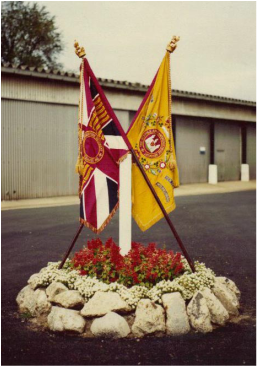
Our ongoing research into the Colours of The Suffolk Regiment was directed to an old Facebook posting from 2012, where a former member of 6th (V) Battalion, Royal Anglian Regiment, had posted a photo of the Colours of The Suffolk and Cambridgeshire Regiment (T.A.), taken we believe at an annual camp sometime in the late 1960s.
Photographs of the Colours of The Suffolk and Cambridgeshire Regiment are exceptionally rare, so to find a colour photograph is extra special.
If anyone out there has any other photographs of the Colours of The Suffolk, Cambridgeshire, and The Suffolk and Cambridgeshire Regiments, please do get in contact with us.
(Posted: 30/03/2015)
Photographs of the Colours of The Suffolk and Cambridgeshire Regiment are exceptionally rare, so to find a colour photograph is extra special.
If anyone out there has any other photographs of the Colours of The Suffolk, Cambridgeshire, and The Suffolk and Cambridgeshire Regiments, please do get in contact with us.
(Posted: 30/03/2015)
Farewell Major Cobbold
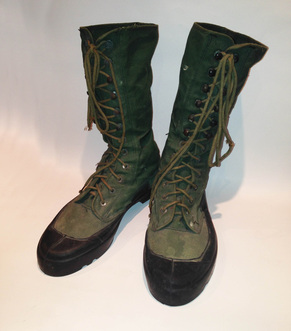
Today the Friends bade farewell to Major Tony Cobbold, former Regimental Secretary and Curator of the Regimental Museum.
In the packed church of St. Andrew at Cotton near Stowmarket, Tony’s family and friends, were joined by many of his former comrades who had come to say goodbye to a true gentleman.
Tony was commissioned from Sandhurst into 1st Battalion, The Suffolk Regiment in 1949 and served with them until its amalgamation in 1959. He would later serve with the 1/1st East Anglian Regiment and The Royal Anglian Regiment, retiring in 1994.
Tony’s first posting with The Suffolk Regiment was to Malaya in 1949, where he would end up as the Battalion's longest serving officer, serving for a record 38 months. Among the items Tony retained from his service with The Suffolk Regiment, were this pair canvas and rubber jungle boots. It was rumoured that the Battalion wore out 30,000 pairs of them during their time in Malaya. I wonder how many patrols Tony trudged wearing this pair?
(Posted: 19/03/2015)
In the packed church of St. Andrew at Cotton near Stowmarket, Tony’s family and friends, were joined by many of his former comrades who had come to say goodbye to a true gentleman.
Tony was commissioned from Sandhurst into 1st Battalion, The Suffolk Regiment in 1949 and served with them until its amalgamation in 1959. He would later serve with the 1/1st East Anglian Regiment and The Royal Anglian Regiment, retiring in 1994.
Tony’s first posting with The Suffolk Regiment was to Malaya in 1949, where he would end up as the Battalion's longest serving officer, serving for a record 38 months. Among the items Tony retained from his service with The Suffolk Regiment, were this pair canvas and rubber jungle boots. It was rumoured that the Battalion wore out 30,000 pairs of them during their time in Malaya. I wonder how many patrols Tony trudged wearing this pair?
(Posted: 19/03/2015)
Happy Mother's Day
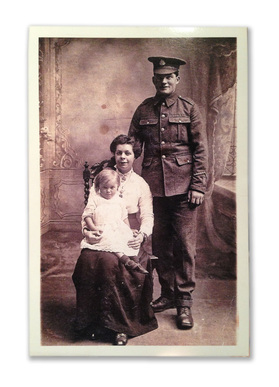
A Happy Mother's Day to all Friends.
The Suffolk Regiment has always been a family regiment where the welfare of the families of it's soldiers was just as important as the men serving within its ranks.
Spare a thought for all our mums today including Agnes Barnes, wife of Corporal Ernest "Kelly" Barnes (left), of 4th Suffolk, who gave birth to their daughter, Nelly, whilst Kelly was away at the Front during the Great War.
Kelly later became the first Standard Bearer for the Ipswich Branch of the Old Comrades Association in 1950.
(Posted: 15/03/2015)
The Suffolk Regiment has always been a family regiment where the welfare of the families of it's soldiers was just as important as the men serving within its ranks.
Spare a thought for all our mums today including Agnes Barnes, wife of Corporal Ernest "Kelly" Barnes (left), of 4th Suffolk, who gave birth to their daughter, Nelly, whilst Kelly was away at the Front during the Great War.
Kelly later became the first Standard Bearer for the Ipswich Branch of the Old Comrades Association in 1950.
(Posted: 15/03/2015)
Regimental Museum Remembers Neuve Chapelle
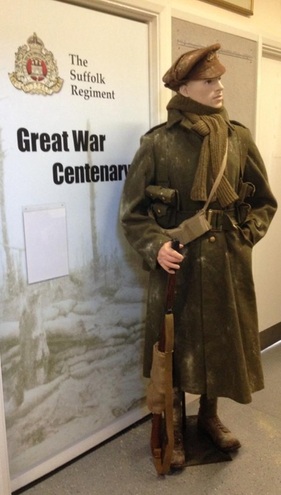
As part of the Suffolk Regiment Museum's ongoing series of exhibits commemorating the Great War, the figure in the downstairs hallway has changed from a Reservist of 2nd Suffolk in August 1914, to a Territorial soldier of 4th Suffolk at Neuve Chapelle in March 1915.
Dressed in greatcoat with 'gor-blimey' cap, he is typical of the Suffolk\Terrier" of 1915.
The next figure is anticipated to be a member of one of the New Army "Service" Battalions who fought at Loos in September and October 1915.
Watch this space for more information!
(Posted: 14/03/2015)
Dressed in greatcoat with 'gor-blimey' cap, he is typical of the Suffolk\Terrier" of 1915.
The next figure is anticipated to be a member of one of the New Army "Service" Battalions who fought at Loos in September and October 1915.
Watch this space for more information!
(Posted: 14/03/2015)
Remembering Neuve Chapelle
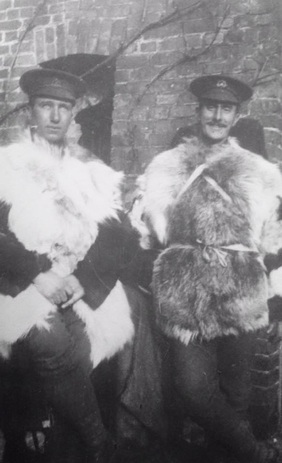
One hundred years ago today, the 4th Battalion were in their newly won positions south of the French village of Neuve Chapelle. They had been fighting since early afternoon and had fought gallantly to take and hold the German second line trenches in front of the Bois de Biez, an area of thick woodland. The day was one of honour but not without great loss to the Battalion.
Their gallantry that day was the first step to establishing the Territorial Battalion's of The Suffolk Regiment on a more equal footing with their regular counterparts. It too, helped pave the way for members of the Territorial Force (T.F.) to be accepted into the Old Comrades Association and for the Battalion to have a regular feature in the Regimental Gazette.
So spare a thought today for all those men of 4th Suffolk who died at Neuve Chapelle in March 1915, and who never made it back to 'Blighty'
(Posted: 12/03/2015)
NB: For those of you following our ongoing record of the Great War, you can read more about the Battalions actions that day on the "Operation Legacy" page of this website.
Their gallantry that day was the first step to establishing the Territorial Battalion's of The Suffolk Regiment on a more equal footing with their regular counterparts. It too, helped pave the way for members of the Territorial Force (T.F.) to be accepted into the Old Comrades Association and for the Battalion to have a regular feature in the Regimental Gazette.
So spare a thought today for all those men of 4th Suffolk who died at Neuve Chapelle in March 1915, and who never made it back to 'Blighty'
(Posted: 12/03/2015)
NB: For those of you following our ongoing record of the Great War, you can read more about the Battalions actions that day on the "Operation Legacy" page of this website.
A Souvenir of National Service
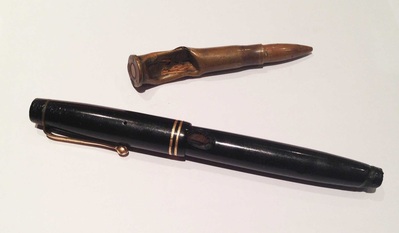
This weekend the Friends have been visiting a former Suffolk soldier who kept some amazing souvenirs from his time with the Regiment.
A bullet scarred fountain pen and a .303 round which stopped another bullet, both taken from the body of a dead communist terrorist, or 'bandit' in the jungles of Malaya in 1952.
A full account of the action will appear in a future edition of the Castle & Key. This is merely a teaser!
(Posted: 01/03/2015)
A bullet scarred fountain pen and a .303 round which stopped another bullet, both taken from the body of a dead communist terrorist, or 'bandit' in the jungles of Malaya in 1952.
A full account of the action will appear in a future edition of the Castle & Key. This is merely a teaser!
(Posted: 01/03/2015)
Happy Valentines Day
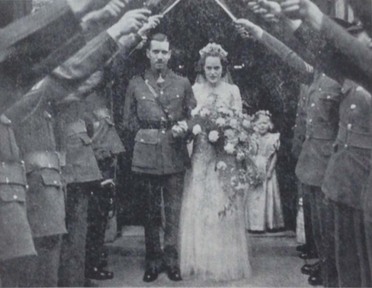
A Happy Valentines Day to all Friends.
The Suffolk Regiment has spawned many a lasting union. Take for instance, the pairing of Captain R.E. Goodwin and Miss Anthea Sampson, who tied the knot in the Regimental Chapel in August 1940.
Dick Goodwin, who had been commissioned onto The Suffolk Regiment in 1928, met his future wife whilst she was working as a member of 40 (Suffolk) Platoon ATS, at Gibraltar Barracks in the early months of the war. He had himself, only just returned from service in India. He would go on to command the Battalion on D-Day and rise to become Lieutenant General Sir Richard Goodwin, KCB, CBE, DSO, enjoying 46 years of happy marriage to Lady Goodwin.
So today, make sure you shower your loved one with affection and remember to get them a large bunch of roses - in Regimental Colours of course, and don't forget the chocolate!!
(Posted: 14/02/2015)
The Suffolk Regiment has spawned many a lasting union. Take for instance, the pairing of Captain R.E. Goodwin and Miss Anthea Sampson, who tied the knot in the Regimental Chapel in August 1940.
Dick Goodwin, who had been commissioned onto The Suffolk Regiment in 1928, met his future wife whilst she was working as a member of 40 (Suffolk) Platoon ATS, at Gibraltar Barracks in the early months of the war. He had himself, only just returned from service in India. He would go on to command the Battalion on D-Day and rise to become Lieutenant General Sir Richard Goodwin, KCB, CBE, DSO, enjoying 46 years of happy marriage to Lady Goodwin.
So today, make sure you shower your loved one with affection and remember to get them a large bunch of roses - in Regimental Colours of course, and don't forget the chocolate!!
(Posted: 14/02/2015)
The Late Arthur Jolley
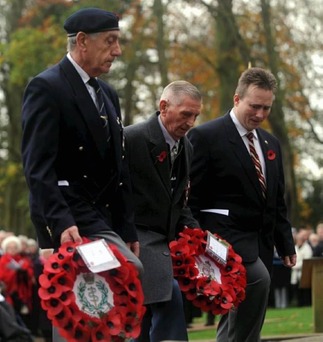
As 2015 progresses, regretfully so does the sadness.
On Saturday, we learnt the sad news of the passing of Arthur Jolley, formerly of 2nd Suffolk, who passed away after a short illness aged an amazing, 104 years old.
Arthur joined the 2nd Battalion in India in 1930 and served with them throughout the 1930s at Fort St. George, Madras, and later on the North-West Frontier.
Arthur was unknown to The Suffolk Regiment until he was discovered by Taff in 2010. At 101 years old, he was still tending his garden and that of his neighbour and he had only just given up driving due to poor eyesight. When the Ipswich and District, Suffolk Regiment Old Comrades was formed, Arthur was a regular early member, attending meetings at the Brewery Tap pub in Ipswich and at the numerous Garden Parties organised by Dick and Jackie May.
Arthur was honoured when we asked him to lay the Suffolk Regiment wreath at the annual Service of Remembrance at the Town's Cenotaph in 2010. Still spritely, he needed no assistance, just a little guidance as he'd never done it before.
Arthur was one of a dying breed; a pre-war regular Suffolk soldier. A unique band of men of which, there cannot now be many left with us.
(Posted: 09/02/2015)
On Saturday, we learnt the sad news of the passing of Arthur Jolley, formerly of 2nd Suffolk, who passed away after a short illness aged an amazing, 104 years old.
Arthur joined the 2nd Battalion in India in 1930 and served with them throughout the 1930s at Fort St. George, Madras, and later on the North-West Frontier.
Arthur was unknown to The Suffolk Regiment until he was discovered by Taff in 2010. At 101 years old, he was still tending his garden and that of his neighbour and he had only just given up driving due to poor eyesight. When the Ipswich and District, Suffolk Regiment Old Comrades was formed, Arthur was a regular early member, attending meetings at the Brewery Tap pub in Ipswich and at the numerous Garden Parties organised by Dick and Jackie May.
Arthur was honoured when we asked him to lay the Suffolk Regiment wreath at the annual Service of Remembrance at the Town's Cenotaph in 2010. Still spritely, he needed no assistance, just a little guidance as he'd never done it before.
Arthur was one of a dying breed; a pre-war regular Suffolk soldier. A unique band of men of which, there cannot now be many left with us.
(Posted: 09/02/2015)
Remembering Winston
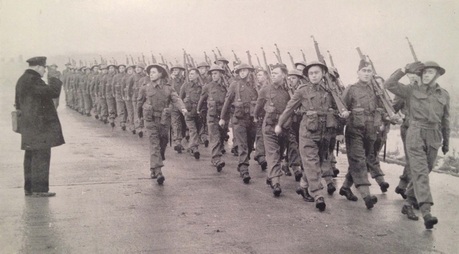
Today marks the 50th anniversary of the State Funeral of Sir Winston Churchill on 30th January 1965.
Winston Spencer Churchill, or ‘WSC’ had a chequered and colourful career. In his early life he participated in the last cavalry charge of the British Army at Omdurman, was captured by the Boers in South Africa but escaped, and commanded an infantry Battalion on the Western Front.
In later life he led this country and it's people through the Second World War from the dark days of 1940 when we stood alone, to victory in Europe five years later.
In May 1941, the 8th Battalion, The Suffolk Regiment; a Battalion destined never to fight on active service, were on coastal duties between Frinton and Walton-on-the-Naze in Essex. On a routine visit to inspect defences, WSC (above) took the salute as Lieutenant Nice’s Platoon of B Company marched past.
Spare a thought today for the soldier, politician, writer and painter. The man who laid the foundations of the world we live in today.
(Posted: 30/01/2015)
Winston Spencer Churchill, or ‘WSC’ had a chequered and colourful career. In his early life he participated in the last cavalry charge of the British Army at Omdurman, was captured by the Boers in South Africa but escaped, and commanded an infantry Battalion on the Western Front.
In later life he led this country and it's people through the Second World War from the dark days of 1940 when we stood alone, to victory in Europe five years later.
In May 1941, the 8th Battalion, The Suffolk Regiment; a Battalion destined never to fight on active service, were on coastal duties between Frinton and Walton-on-the-Naze in Essex. On a routine visit to inspect defences, WSC (above) took the salute as Lieutenant Nice’s Platoon of B Company marched past.
Spare a thought today for the soldier, politician, writer and painter. The man who laid the foundations of the world we live in today.
(Posted: 30/01/2015)
Finally, It Arrives
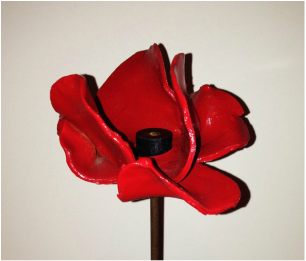
After waiting for several weeks, and seeing many friends and family receive theirs, today the poppy I ordered last year finally arrived.
In the plethora of over-priced, tacky merchandise, cashing-in on the centenary of the Great War, this seemed the only real tasteful piece of remembrance worth purchasing.
Although it will need a thorough clean, as it still contains mud from the moat of the Tower of London, it's currently resting on the bookcase awaiting a fitting home. It's my remembrance to the 7106 men of The Suffolk Regiment who died on active service during the Great War.
Lest We Forget.
(Posted: 23/01/2015)
In the plethora of over-priced, tacky merchandise, cashing-in on the centenary of the Great War, this seemed the only real tasteful piece of remembrance worth purchasing.
Although it will need a thorough clean, as it still contains mud from the moat of the Tower of London, it's currently resting on the bookcase awaiting a fitting home. It's my remembrance to the 7106 men of The Suffolk Regiment who died on active service during the Great War.
Lest We Forget.
(Posted: 23/01/2015)
Ah...So That's What It's For!
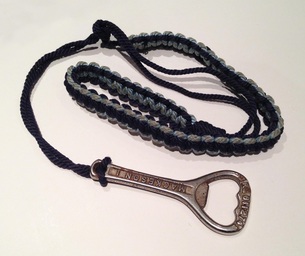
Quite often when we get asked to look at photographs of Suffolk Regiment soldiers, we're asked "what's that around his arm?" and we tell them "It's a lanyard,"
"Oh" they ask, "What's it for?" and often were stumped to provide them an answer!
A lanyard quite often had a jack knife on the end of it or a whistle for an NCO - the theory being that it was close to hand, but secured so he didn't loose it. However as the years progressed, they became more ceremonial than practical.
Recently, we found an original Cambridgeshire Regiment lanyard in a junk shop which had on one end of it, a Mackeson's Stout bottle opener. Soldiers have always liked a beer and this Cambridgeshire TA man must have liked a drink after parade. Where better to keep your bottle opener than in your top pocket and safe on the end of your lanyard!
(Posted: 16/01/2015)
"Oh" they ask, "What's it for?" and often were stumped to provide them an answer!
A lanyard quite often had a jack knife on the end of it or a whistle for an NCO - the theory being that it was close to hand, but secured so he didn't loose it. However as the years progressed, they became more ceremonial than practical.
Recently, we found an original Cambridgeshire Regiment lanyard in a junk shop which had on one end of it, a Mackeson's Stout bottle opener. Soldiers have always liked a beer and this Cambridgeshire TA man must have liked a drink after parade. Where better to keep your bottle opener than in your top pocket and safe on the end of your lanyard!
(Posted: 16/01/2015)
Sad Times
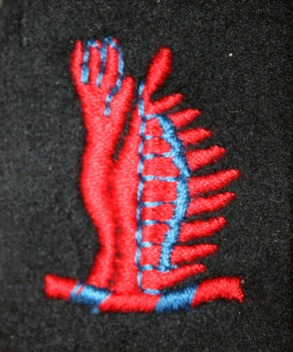
2015 seems to be a very sad year for The Suffolk Regiment. Today we have learnt from Regimental Headquarters of the loss of Lieutenant John Wright, who served with the 1st Battalion in Trieste and Germany.
Christopher John Wright was commissioned into The Suffolk Regiment from Eaton Hall OTC on June 12th 1954 and joined the 1st Battalion in Trieste shortly afterwards. He arrived just after they had celebrated The Queen's Official Birthday.
From Trieste, he went with the Battalion to Germany in August 1954 where it was to form part of the 6th Infantry Brigade in a multi-national 'Cold-War' NATO Army.
John was present on the parade at Wuppertal on May 23rd 1955, when New Colours were presented to the Battalion by the Colonel-in-Chief, H.R.H. The Princess Margaret. John ended his regular service with the Regiment at Roman Way Camp, Colchester in July 1956; where the Battalion were in temporary accommodation, awaiting a move to their new posting on the troubled Mediterranean island of Cyprus. He would however remain on the reserve of officers, serving the customary 3 years with the Territorial Army in Suffolk after his release from the Regiment.
In his time with the Regiment, John saw it change from its traditional role of infantry, to a nuclear-age striking force, before it once more ended it's days as colonial peacekeepers.
(Posted: 12/01/2015)
Christopher John Wright was commissioned into The Suffolk Regiment from Eaton Hall OTC on June 12th 1954 and joined the 1st Battalion in Trieste shortly afterwards. He arrived just after they had celebrated The Queen's Official Birthday.
From Trieste, he went with the Battalion to Germany in August 1954 where it was to form part of the 6th Infantry Brigade in a multi-national 'Cold-War' NATO Army.
John was present on the parade at Wuppertal on May 23rd 1955, when New Colours were presented to the Battalion by the Colonel-in-Chief, H.R.H. The Princess Margaret. John ended his regular service with the Regiment at Roman Way Camp, Colchester in July 1956; where the Battalion were in temporary accommodation, awaiting a move to their new posting on the troubled Mediterranean island of Cyprus. He would however remain on the reserve of officers, serving the customary 3 years with the Territorial Army in Suffolk after his release from the Regiment.
In his time with the Regiment, John saw it change from its traditional role of infantry, to a nuclear-age striking force, before it once more ended it's days as colonial peacekeepers.
(Posted: 12/01/2015)
Ever Wondered How A Regimental Badge Is Made?
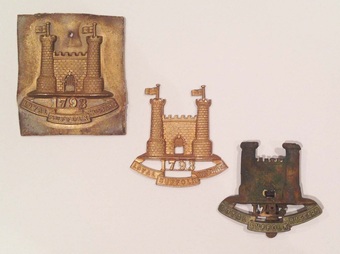
Ever wondered how a regimental badge is made?
Well, today leafing through a vintage market, we came across two unfinished bronze Suffolk Yeomanry officers collar badges.
Top left shows the first stage of a badges manufacture. It involved the badge being stamped from a sheet of bronze (or brass or white metal) under great force. Force was needed to ensure that the fine definition, like the stones of the castle and the portcullis, were formed perfectly. If the force was not sufficient enough then, it might not form a perfect stamping and give a blurred definition.
The centre badge is what fettled or 'fretted' badge looked like with all the excess metal carefully cut away. The next stage would have been to braise on two lugs or a slider onto the rear so it could be placed in a cap or on a collar, and the final stage was to dip the badge in a solution of chemicals to give it an aged 'bronzed' appearance.
The final image, shown for reference, shows an other ranks badge belonging to Suffolk Yeoman Paul Blake who served with the Loyal Suffolk Hussars from 1913 until 1917, when they became the 15th Battalion, the Suffolk Regiment. Fiercely proud to be a Suffolk Hussar, even when the badge had lost its flags on the castles turrets and the slider had snapped off the rear, he soldered on another slider in the Gaza desert and wore it continually when the Regiment went to France in 1918. It was found wrapped in cloth, in a tin in his garden shed when he died in 1978. All his life, he treasured it.
(Posted: 09/01/2015)
Well, today leafing through a vintage market, we came across two unfinished bronze Suffolk Yeomanry officers collar badges.
Top left shows the first stage of a badges manufacture. It involved the badge being stamped from a sheet of bronze (or brass or white metal) under great force. Force was needed to ensure that the fine definition, like the stones of the castle and the portcullis, were formed perfectly. If the force was not sufficient enough then, it might not form a perfect stamping and give a blurred definition.
The centre badge is what fettled or 'fretted' badge looked like with all the excess metal carefully cut away. The next stage would have been to braise on two lugs or a slider onto the rear so it could be placed in a cap or on a collar, and the final stage was to dip the badge in a solution of chemicals to give it an aged 'bronzed' appearance.
The final image, shown for reference, shows an other ranks badge belonging to Suffolk Yeoman Paul Blake who served with the Loyal Suffolk Hussars from 1913 until 1917, when they became the 15th Battalion, the Suffolk Regiment. Fiercely proud to be a Suffolk Hussar, even when the badge had lost its flags on the castles turrets and the slider had snapped off the rear, he soldered on another slider in the Gaza desert and wore it continually when the Regiment went to France in 1918. It was found wrapped in cloth, in a tin in his garden shed when he died in 1978. All his life, he treasured it.
(Posted: 09/01/2015)
The Loss of Lieutenant-Colonel William Gordon, OBE
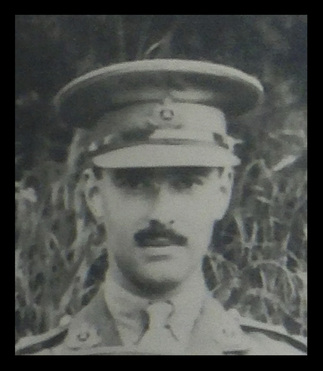
It is with much regret that we open our news of the New Year with an obituary.
We are sorry to announce the loss of Lieutenant-Colonel William David Gordon OBE, who passed away peacefully just before Christmas, a few weeks before his 100th Birthday.
Commissioned into The Suffolk Regiment in August 1935, he and fellow Sandhurst graduate Charles Boycott (both the same intake) would both stay with the 1st Battalion until 1954.
As part of the initial British Expeditionary Force, he crossed to France in October 1939 as the Battalion Transport Officer. After the evacuation from Dunkirk, he remained with the Battalion in England, returning to France with them on D-Day as the Commander of Support Platoon - setting foot in France just after 10.00am on 6th June 1944, with the Battalions 3" Mortars, 6pdr guns and Pioneers troops.
It was in this role that he was to remain until 15th July 1944, when he was badly wounded by enemy mortar fire whilst the Battalion were in the consolidated positions around the area of the Chateau de la Londe, near Caen; a position they had fought hard to capture some two weeks previously. An almost direct hit blew off one foot and a hefty section of his lower leg, but amazingly, left him with very few other injuries.
In other less determined officers, this disability would have been fatal, but it had very little effect on William's military career. After recuperation, he rejoined the Battalion in Palestine, but remained in the UK when the Battalion went to Malaya. He rejoined them briefly in Trieste.
William had remained relatively unknown to the Regiment in the years following amalgamation. He is believed to have been the last surviving pre-war Sandhurst commissioned, Suffolk Regiment officer. His passing marks the closing of another chapter in the history of The Suffolk Regiment.
(Posted: 02/01/2015)
We are sorry to announce the loss of Lieutenant-Colonel William David Gordon OBE, who passed away peacefully just before Christmas, a few weeks before his 100th Birthday.
Commissioned into The Suffolk Regiment in August 1935, he and fellow Sandhurst graduate Charles Boycott (both the same intake) would both stay with the 1st Battalion until 1954.
As part of the initial British Expeditionary Force, he crossed to France in October 1939 as the Battalion Transport Officer. After the evacuation from Dunkirk, he remained with the Battalion in England, returning to France with them on D-Day as the Commander of Support Platoon - setting foot in France just after 10.00am on 6th June 1944, with the Battalions 3" Mortars, 6pdr guns and Pioneers troops.
It was in this role that he was to remain until 15th July 1944, when he was badly wounded by enemy mortar fire whilst the Battalion were in the consolidated positions around the area of the Chateau de la Londe, near Caen; a position they had fought hard to capture some two weeks previously. An almost direct hit blew off one foot and a hefty section of his lower leg, but amazingly, left him with very few other injuries.
In other less determined officers, this disability would have been fatal, but it had very little effect on William's military career. After recuperation, he rejoined the Battalion in Palestine, but remained in the UK when the Battalion went to Malaya. He rejoined them briefly in Trieste.
William had remained relatively unknown to the Regiment in the years following amalgamation. He is believed to have been the last surviving pre-war Sandhurst commissioned, Suffolk Regiment officer. His passing marks the closing of another chapter in the history of The Suffolk Regiment.
(Posted: 02/01/2015)
A Happy New Year To All Friends
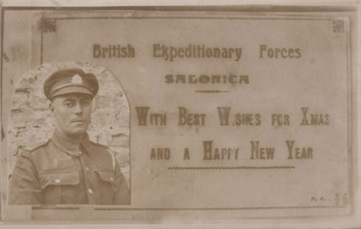
Happy New Year to all Friends!
2015 promises to be yet again another fantastic year so make a resolution to join us in our 8th year and be a part of a unique organisation dedicated to keeping alive the history and traditions of The Suffolk Regiment.
(Posted: 01/01/15)
2015 promises to be yet again another fantastic year so make a resolution to join us in our 8th year and be a part of a unique organisation dedicated to keeping alive the history and traditions of The Suffolk Regiment.
(Posted: 01/01/15)
Main Picture: Colour Sergeant Pretty distributes thermos flasks of tea at Zu Seckenhausen, April 1945.
